Project Management Concepts and Tools
VerifiedAdded on 2020/06/04
|22
|4871
|44
AI Summary
This assignment delves into the fundamental principles of project management, covering various methodologies and best practices. It examines essential tools such as Work Breakdown Structures (WBS), Gantt charts, Network Diagrams, and Stakeholder Analysis. The discussion highlights the importance of aligning projects with business strategies and emphasizes the role of Earned Value Management (EVM) in performance tracking. Real-world case studies and examples are used to illustrate the practical application of these concepts.
Contribute Materials
Your contribution can guide someone’s learning journey. Share your
documents today.
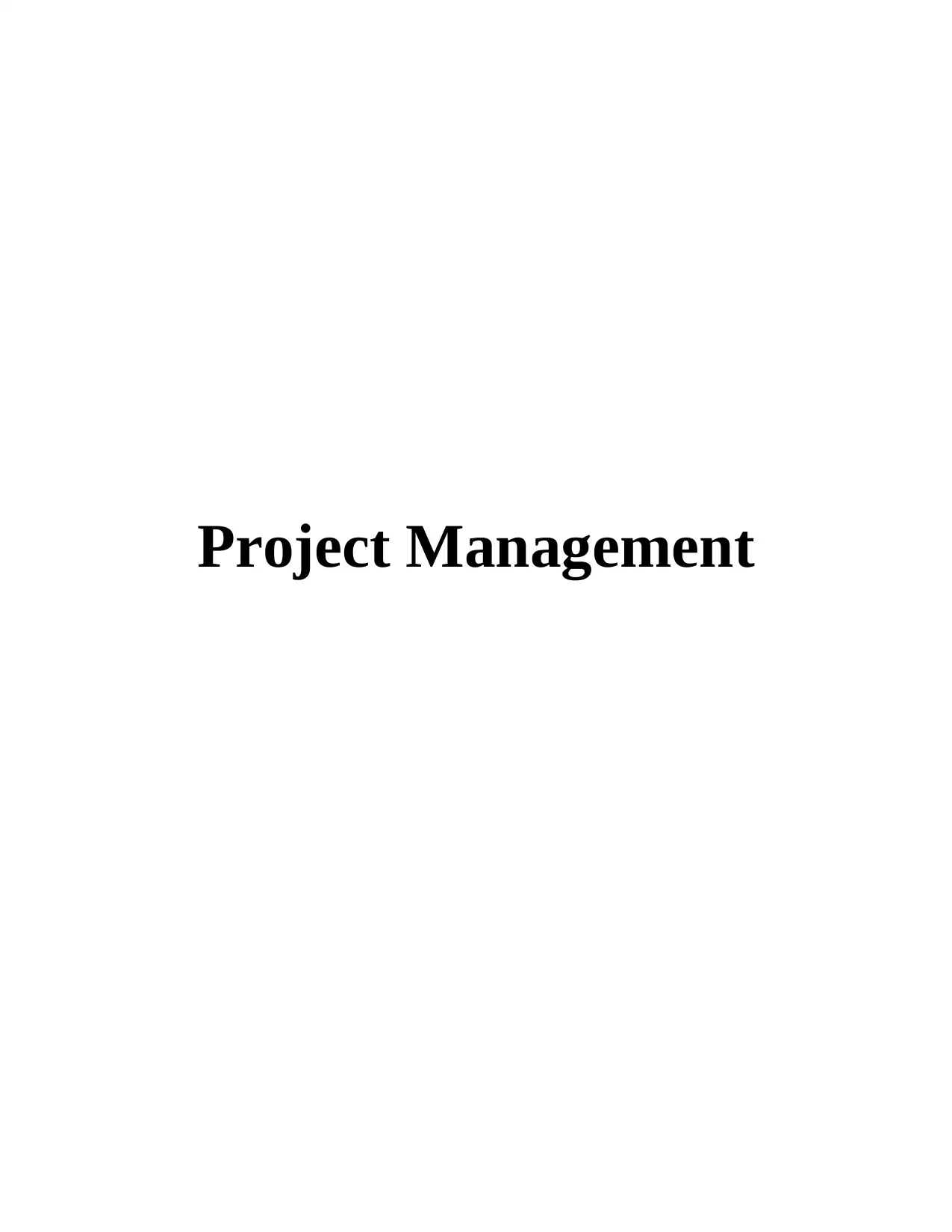
Project Management
Secure Best Marks with AI Grader
Need help grading? Try our AI Grader for instant feedback on your assignments.
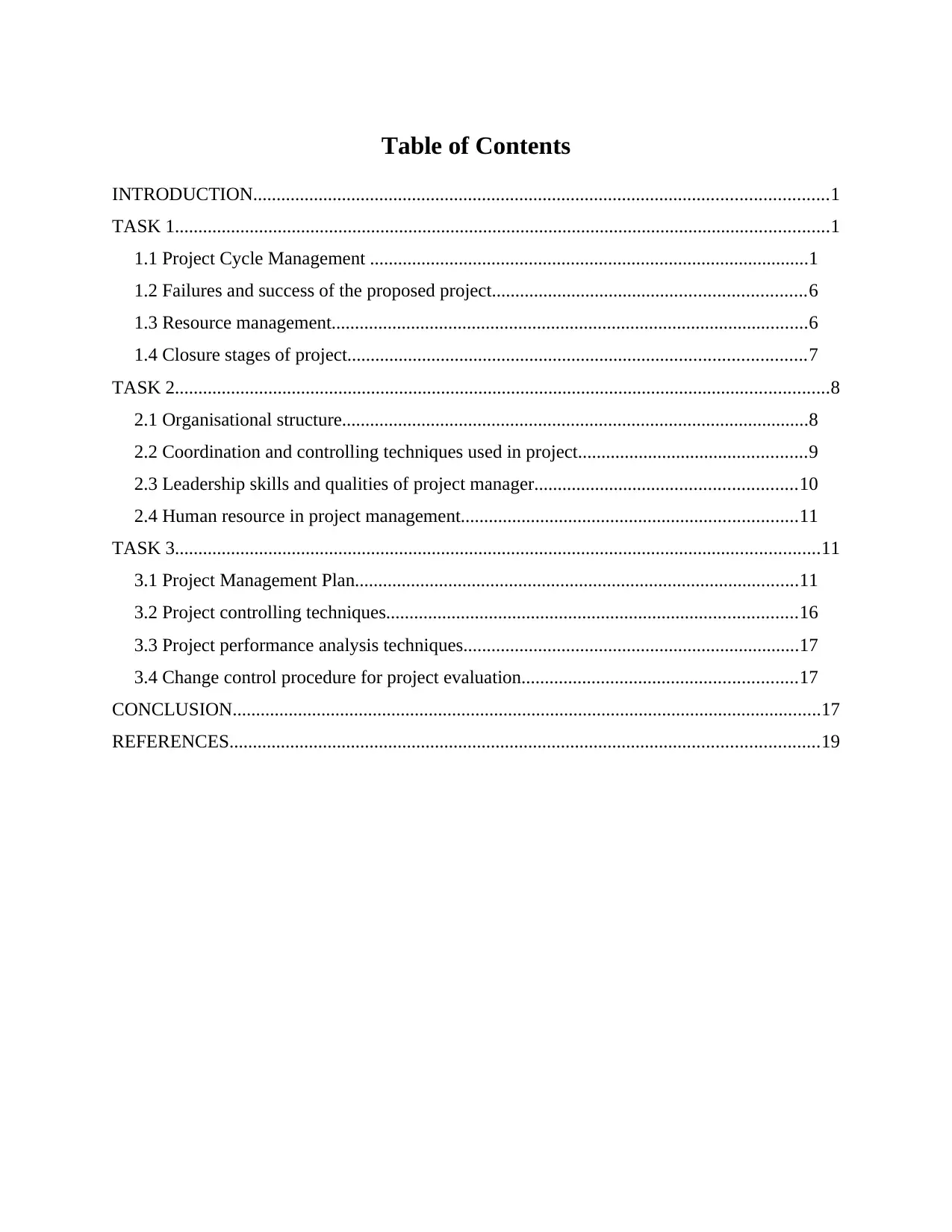
Table of Contents
INTRODUCTION...........................................................................................................................1
TASK 1............................................................................................................................................1
1.1 Project Cycle Management ..............................................................................................1
1.2 Failures and success of the proposed project...................................................................6
1.3 Resource management......................................................................................................6
1.4 Closure stages of project..................................................................................................7
TASK 2............................................................................................................................................8
2.1 Organisational structure....................................................................................................8
2.2 Coordination and controlling techniques used in project.................................................9
2.3 Leadership skills and qualities of project manager........................................................10
2.4 Human resource in project management........................................................................11
TASK 3..........................................................................................................................................11
3.1 Project Management Plan...............................................................................................11
3.2 Project controlling techniques........................................................................................16
3.3 Project performance analysis techniques........................................................................17
3.4 Change control procedure for project evaluation...........................................................17
CONCLUSION..............................................................................................................................17
REFERENCES..............................................................................................................................19
INTRODUCTION...........................................................................................................................1
TASK 1............................................................................................................................................1
1.1 Project Cycle Management ..............................................................................................1
1.2 Failures and success of the proposed project...................................................................6
1.3 Resource management......................................................................................................6
1.4 Closure stages of project..................................................................................................7
TASK 2............................................................................................................................................8
2.1 Organisational structure....................................................................................................8
2.2 Coordination and controlling techniques used in project.................................................9
2.3 Leadership skills and qualities of project manager........................................................10
2.4 Human resource in project management........................................................................11
TASK 3..........................................................................................................................................11
3.1 Project Management Plan...............................................................................................11
3.2 Project controlling techniques........................................................................................16
3.3 Project performance analysis techniques........................................................................17
3.4 Change control procedure for project evaluation...........................................................17
CONCLUSION..............................................................................................................................17
REFERENCES..............................................................................................................................19
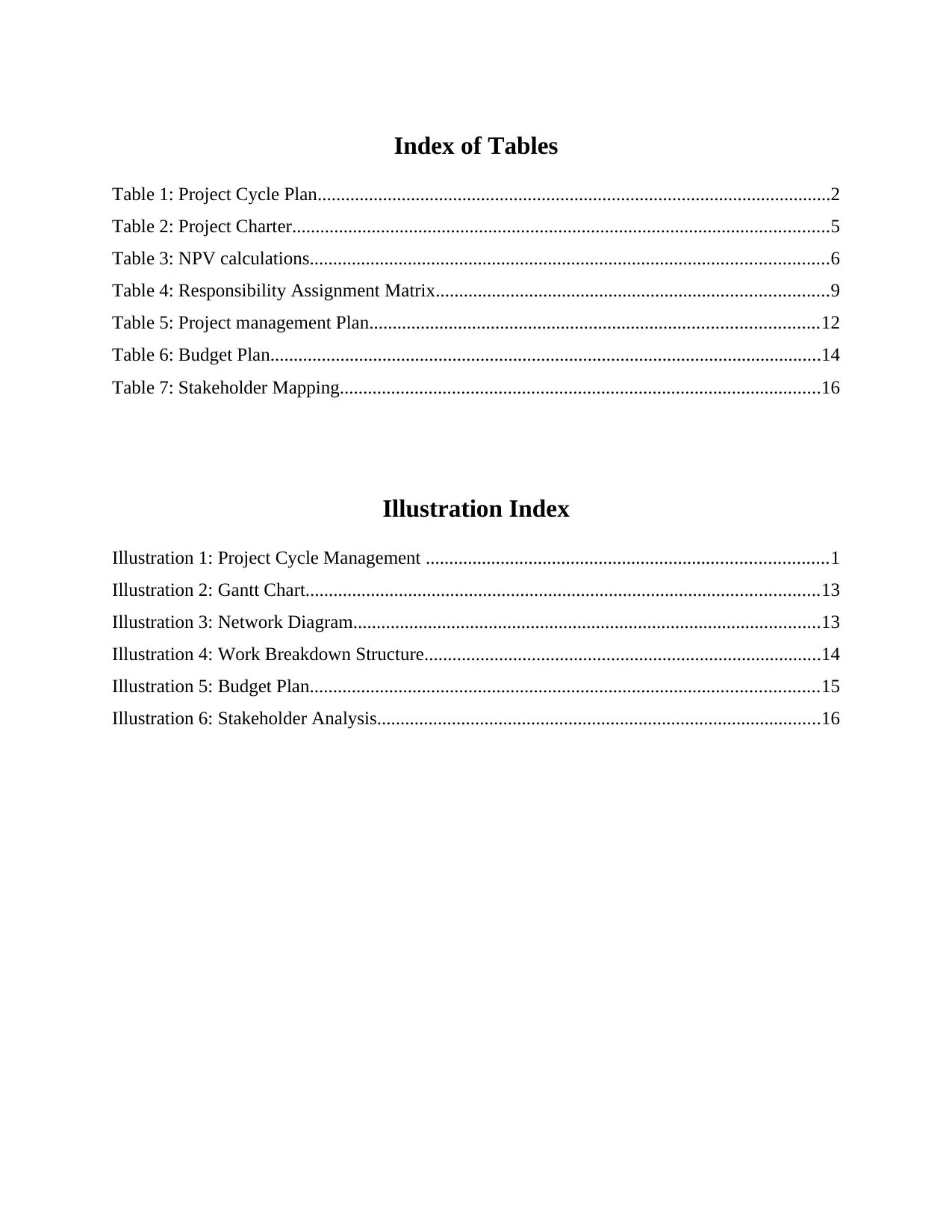
Index of Tables
Table 1: Project Cycle Plan..............................................................................................................2
Table 2: Project Charter...................................................................................................................5
Table 3: NPV calculations...............................................................................................................6
Table 4: Responsibility Assignment Matrix....................................................................................9
Table 5: Project management Plan................................................................................................12
Table 6: Budget Plan......................................................................................................................14
Table 7: Stakeholder Mapping.......................................................................................................16
Illustration Index
Illustration 1: Project Cycle Management ......................................................................................1
Illustration 2: Gantt Chart..............................................................................................................13
Illustration 3: Network Diagram....................................................................................................13
Illustration 4: Work Breakdown Structure.....................................................................................14
Illustration 5: Budget Plan.............................................................................................................15
Illustration 6: Stakeholder Analysis...............................................................................................16
Table 1: Project Cycle Plan..............................................................................................................2
Table 2: Project Charter...................................................................................................................5
Table 3: NPV calculations...............................................................................................................6
Table 4: Responsibility Assignment Matrix....................................................................................9
Table 5: Project management Plan................................................................................................12
Table 6: Budget Plan......................................................................................................................14
Table 7: Stakeholder Mapping.......................................................................................................16
Illustration Index
Illustration 1: Project Cycle Management ......................................................................................1
Illustration 2: Gantt Chart..............................................................................................................13
Illustration 3: Network Diagram....................................................................................................13
Illustration 4: Work Breakdown Structure.....................................................................................14
Illustration 5: Budget Plan.............................................................................................................15
Illustration 6: Stakeholder Analysis...............................................................................................16
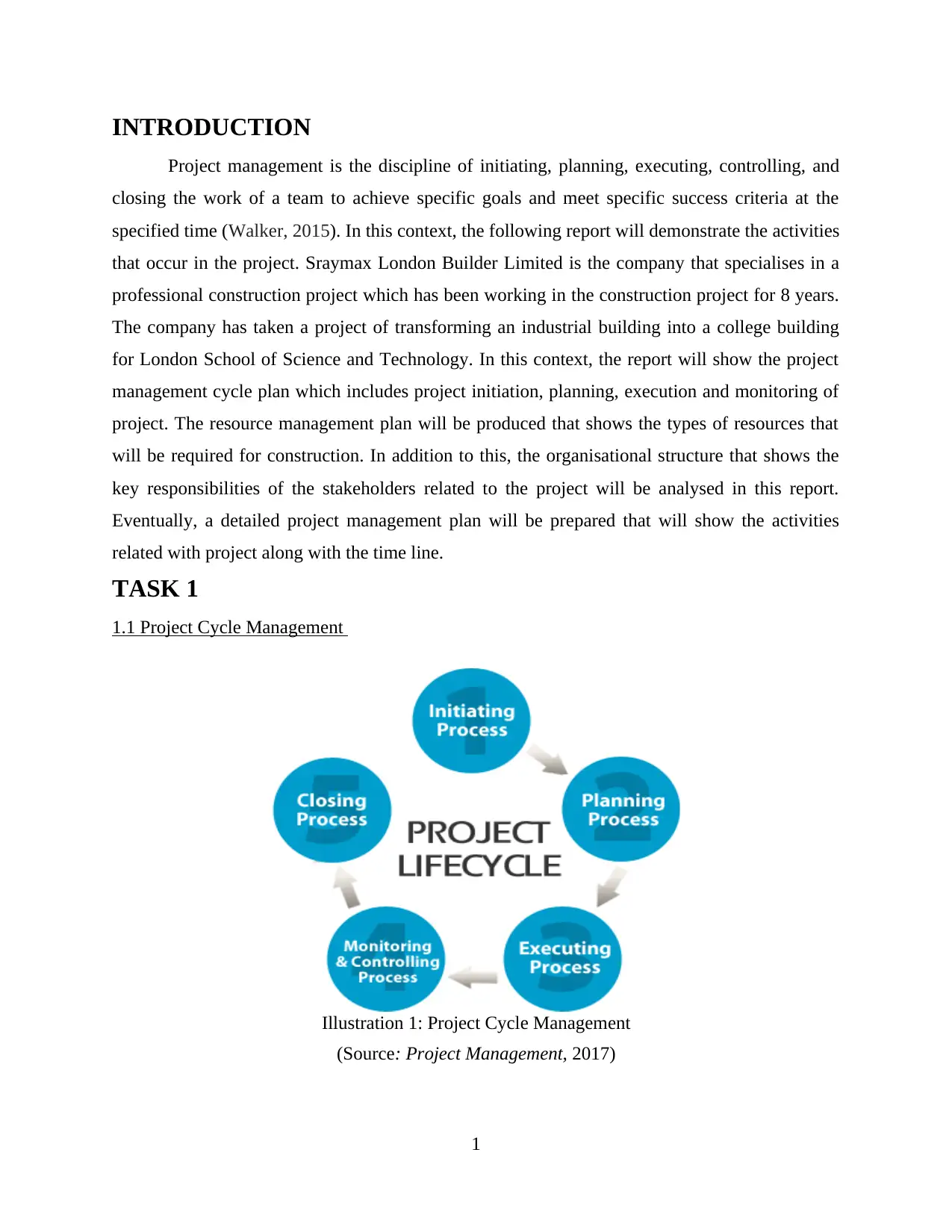
INTRODUCTION
Project management is the discipline of initiating, planning, executing, controlling, and
closing the work of a team to achieve specific goals and meet specific success criteria at the
specified time (Walker, 2015). In this context, the following report will demonstrate the activities
that occur in the project. Sraymax London Builder Limited is the company that specialises in a
professional construction project which has been working in the construction project for 8 years.
The company has taken a project of transforming an industrial building into a college building
for London School of Science and Technology. In this context, the report will show the project
management cycle plan which includes project initiation, planning, execution and monitoring of
project. The resource management plan will be produced that shows the types of resources that
will be required for construction. In addition to this, the organisational structure that shows the
key responsibilities of the stakeholders related to the project will be analysed in this report.
Eventually, a detailed project management plan will be prepared that will show the activities
related with project along with the time line.
TASK 1
1.1 Project Cycle Management
1
Illustration 1: Project Cycle Management
(Source: Project Management, 2017)
Project management is the discipline of initiating, planning, executing, controlling, and
closing the work of a team to achieve specific goals and meet specific success criteria at the
specified time (Walker, 2015). In this context, the following report will demonstrate the activities
that occur in the project. Sraymax London Builder Limited is the company that specialises in a
professional construction project which has been working in the construction project for 8 years.
The company has taken a project of transforming an industrial building into a college building
for London School of Science and Technology. In this context, the report will show the project
management cycle plan which includes project initiation, planning, execution and monitoring of
project. The resource management plan will be produced that shows the types of resources that
will be required for construction. In addition to this, the organisational structure that shows the
key responsibilities of the stakeholders related to the project will be analysed in this report.
Eventually, a detailed project management plan will be prepared that will show the activities
related with project along with the time line.
TASK 1
1.1 Project Cycle Management
1
Illustration 1: Project Cycle Management
(Source: Project Management, 2017)
Secure Best Marks with AI Grader
Need help grading? Try our AI Grader for instant feedback on your assignments.
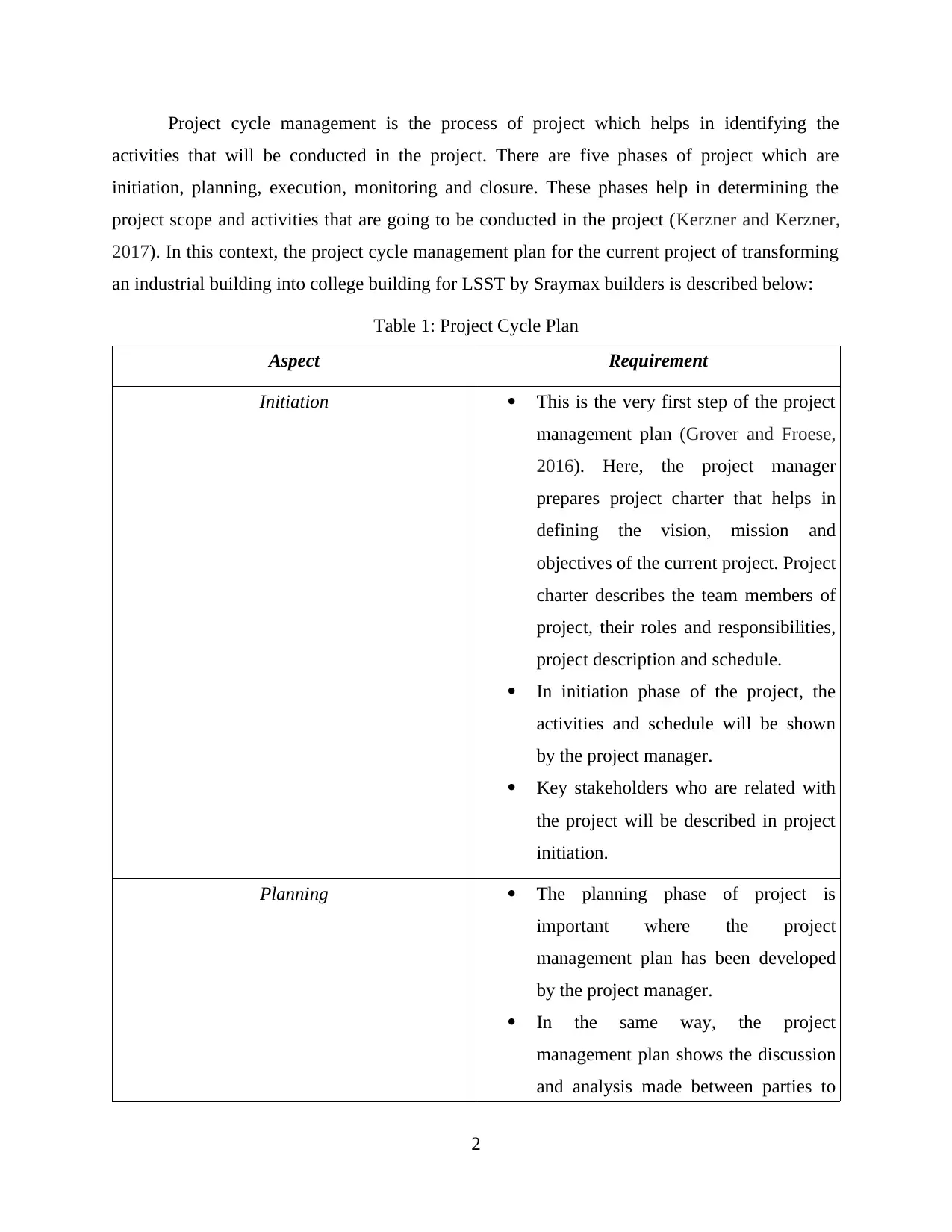
Project cycle management is the process of project which helps in identifying the
activities that will be conducted in the project. There are five phases of project which are
initiation, planning, execution, monitoring and closure. These phases help in determining the
project scope and activities that are going to be conducted in the project (Kerzner and Kerzner,
2017). In this context, the project cycle management plan for the current project of transforming
an industrial building into college building for LSST by Sraymax builders is described below:
Table 1: Project Cycle Plan
Aspect Requirement
Initiation This is the very first step of the project
management plan (Grover and Froese,
2016). Here, the project manager
prepares project charter that helps in
defining the vision, mission and
objectives of the current project. Project
charter describes the team members of
project, their roles and responsibilities,
project description and schedule.
In initiation phase of the project, the
activities and schedule will be shown
by the project manager.
Key stakeholders who are related with
the project will be described in project
initiation.
Planning The planning phase of project is
important where the project
management plan has been developed
by the project manager.
In the same way, the project
management plan shows the discussion
and analysis made between parties to
2
activities that will be conducted in the project. There are five phases of project which are
initiation, planning, execution, monitoring and closure. These phases help in determining the
project scope and activities that are going to be conducted in the project (Kerzner and Kerzner,
2017). In this context, the project cycle management plan for the current project of transforming
an industrial building into college building for LSST by Sraymax builders is described below:
Table 1: Project Cycle Plan
Aspect Requirement
Initiation This is the very first step of the project
management plan (Grover and Froese,
2016). Here, the project manager
prepares project charter that helps in
defining the vision, mission and
objectives of the current project. Project
charter describes the team members of
project, their roles and responsibilities,
project description and schedule.
In initiation phase of the project, the
activities and schedule will be shown
by the project manager.
Key stakeholders who are related with
the project will be described in project
initiation.
Planning The planning phase of project is
important where the project
management plan has been developed
by the project manager.
In the same way, the project
management plan shows the discussion
and analysis made between parties to
2
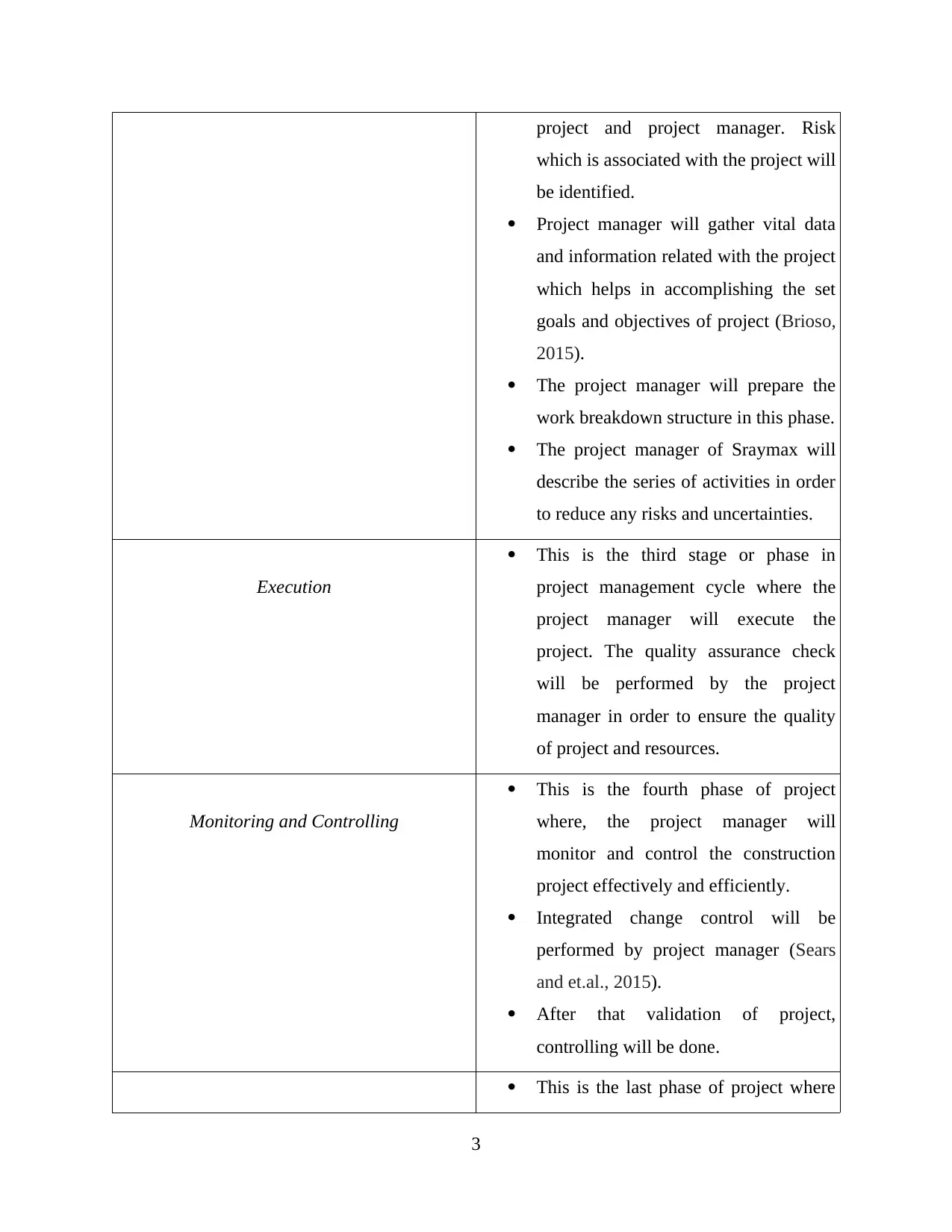
project and project manager. Risk
which is associated with the project will
be identified.
Project manager will gather vital data
and information related with the project
which helps in accomplishing the set
goals and objectives of project (Brioso,
2015).
The project manager will prepare the
work breakdown structure in this phase.
The project manager of Sraymax will
describe the series of activities in order
to reduce any risks and uncertainties.
Execution
This is the third stage or phase in
project management cycle where the
project manager will execute the
project. The quality assurance check
will be performed by the project
manager in order to ensure the quality
of project and resources.
Monitoring and Controlling
This is the fourth phase of project
where, the project manager will
monitor and control the construction
project effectively and efficiently.
Integrated change control will be
performed by project manager (Sears
and et.al., 2015).
After that validation of project,
controlling will be done.
This is the last phase of project where
3
which is associated with the project will
be identified.
Project manager will gather vital data
and information related with the project
which helps in accomplishing the set
goals and objectives of project (Brioso,
2015).
The project manager will prepare the
work breakdown structure in this phase.
The project manager of Sraymax will
describe the series of activities in order
to reduce any risks and uncertainties.
Execution
This is the third stage or phase in
project management cycle where the
project manager will execute the
project. The quality assurance check
will be performed by the project
manager in order to ensure the quality
of project and resources.
Monitoring and Controlling
This is the fourth phase of project
where, the project manager will
monitor and control the construction
project effectively and efficiently.
Integrated change control will be
performed by project manager (Sears
and et.al., 2015).
After that validation of project,
controlling will be done.
This is the last phase of project where
3
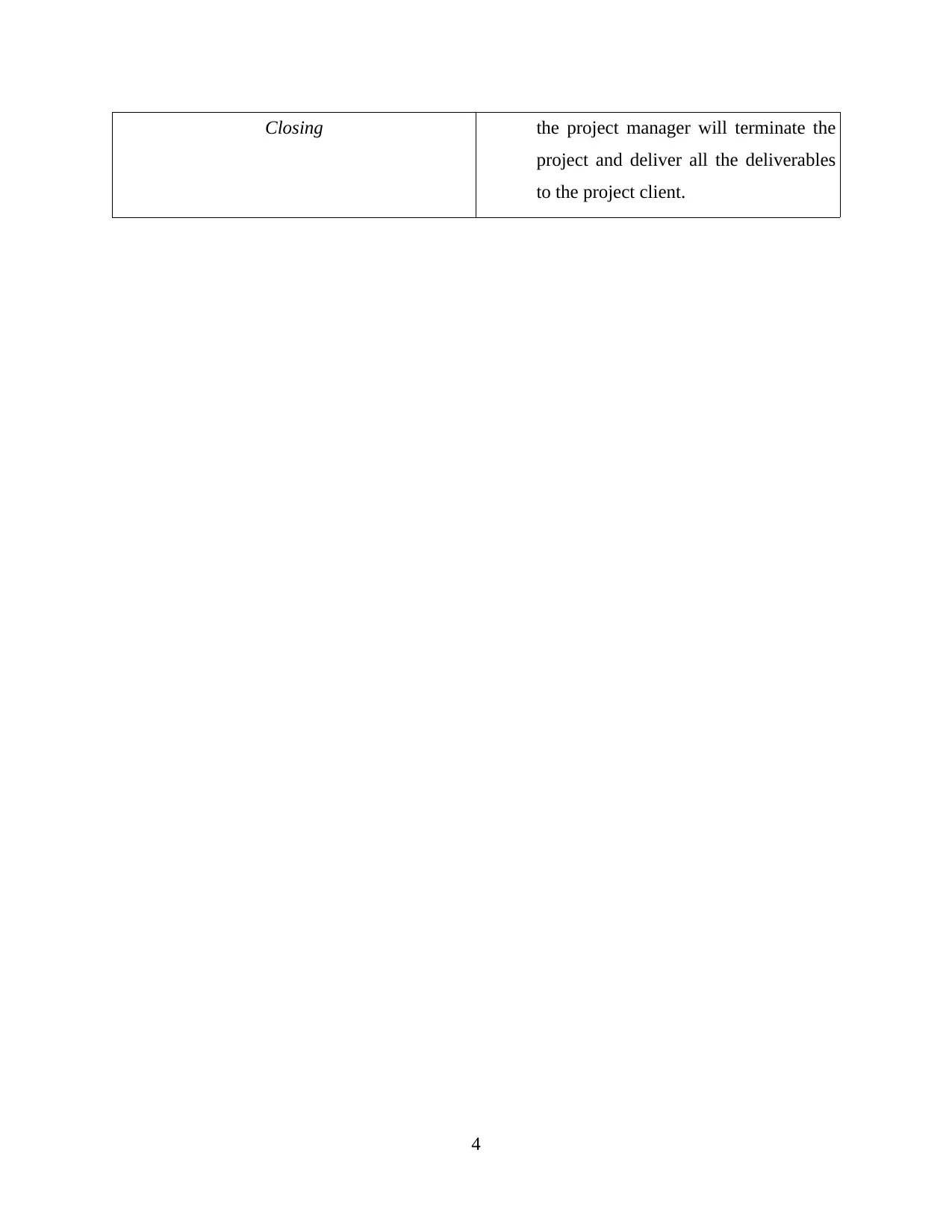
Closing the project manager will terminate the
project and deliver all the deliverables
to the project client.
4
project and deliver all the deliverables
to the project client.
4
Paraphrase This Document
Need a fresh take? Get an instant paraphrase of this document with our AI Paraphraser
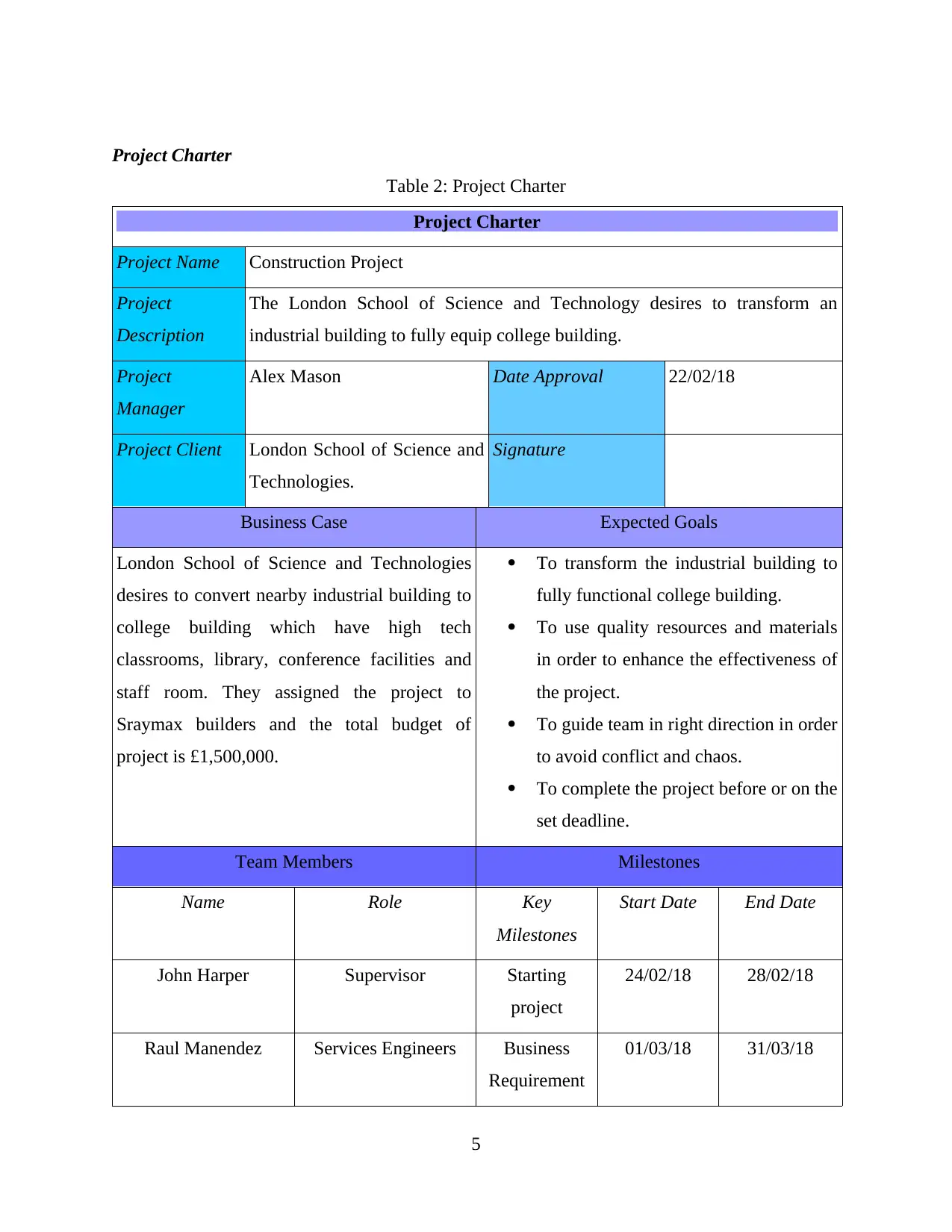
Project Charter
Table 2: Project Charter
Project Charter
Project Name Construction Project
Project
Description
The London School of Science and Technology desires to transform an
industrial building to fully equip college building.
Project
Manager
Alex Mason Date Approval 22/02/18
Project Client London School of Science and
Technologies.
Signature
Business Case Expected Goals
London School of Science and Technologies
desires to convert nearby industrial building to
college building which have high tech
classrooms, library, conference facilities and
staff room. They assigned the project to
Sraymax builders and the total budget of
project is £1,500,000.
To transform the industrial building to
fully functional college building.
To use quality resources and materials
in order to enhance the effectiveness of
the project.
To guide team in right direction in order
to avoid conflict and chaos.
To complete the project before or on the
set deadline.
Team Members Milestones
Name Role Key
Milestones
Start Date End Date
John Harper Supervisor Starting
project
24/02/18 28/02/18
Raul Manendez Services Engineers Business
Requirement
01/03/18 31/03/18
5
Table 2: Project Charter
Project Charter
Project Name Construction Project
Project
Description
The London School of Science and Technology desires to transform an
industrial building to fully equip college building.
Project
Manager
Alex Mason Date Approval 22/02/18
Project Client London School of Science and
Technologies.
Signature
Business Case Expected Goals
London School of Science and Technologies
desires to convert nearby industrial building to
college building which have high tech
classrooms, library, conference facilities and
staff room. They assigned the project to
Sraymax builders and the total budget of
project is £1,500,000.
To transform the industrial building to
fully functional college building.
To use quality resources and materials
in order to enhance the effectiveness of
the project.
To guide team in right direction in order
to avoid conflict and chaos.
To complete the project before or on the
set deadline.
Team Members Milestones
Name Role Key
Milestones
Start Date End Date
John Harper Supervisor Starting
project
24/02/18 28/02/18
Raul Manendez Services Engineers Business
Requirement
01/03/18 31/03/18
5
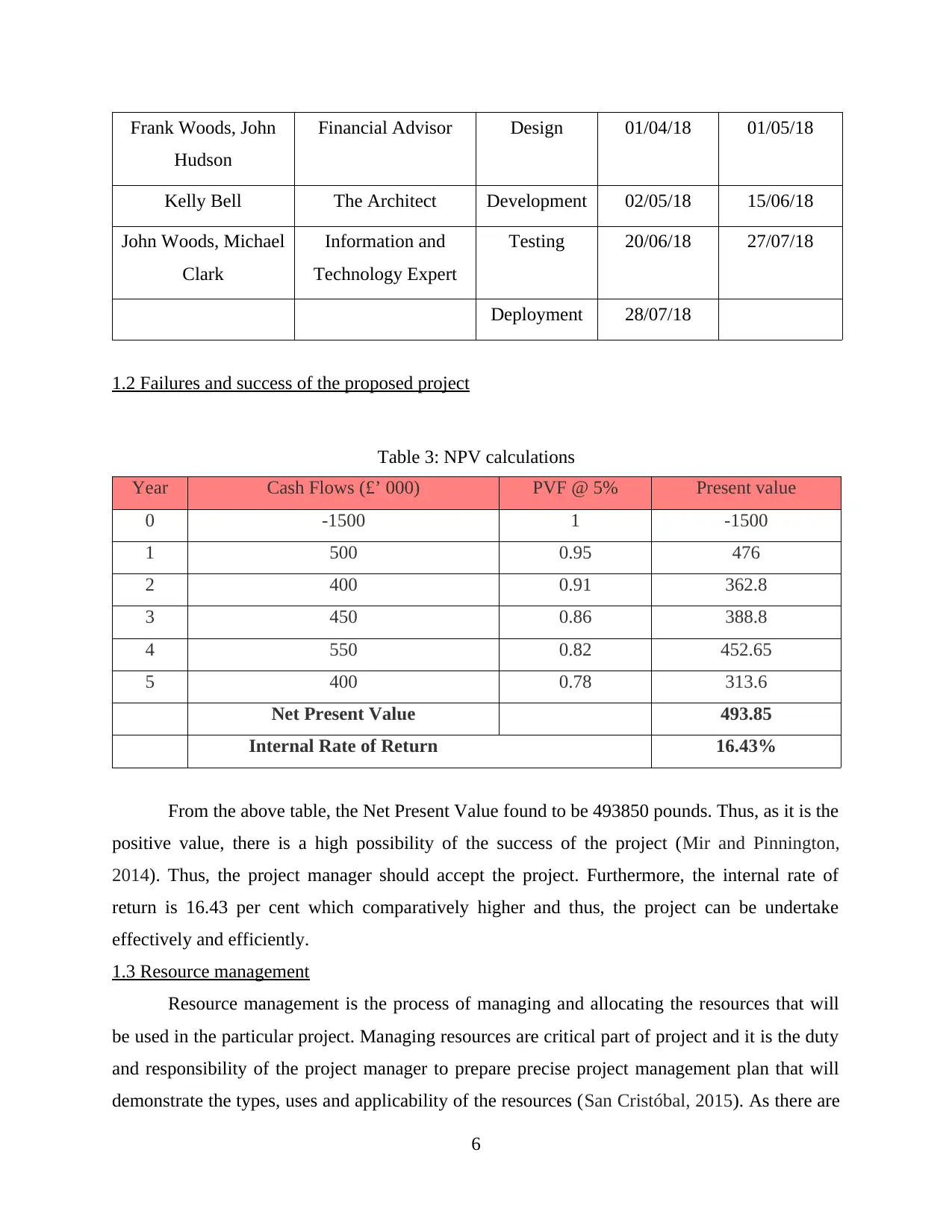
Frank Woods, John
Hudson
Financial Advisor Design 01/04/18 01/05/18
Kelly Bell The Architect Development 02/05/18 15/06/18
John Woods, Michael
Clark
Information and
Technology Expert
Testing 20/06/18 27/07/18
Deployment 28/07/18
1.2 Failures and success of the proposed project
Table 3: NPV calculations
Year Cash Flows (£’ 000) PVF @ 5% Present value
0 -1500 1 -1500
1 500 0.95 476
2 400 0.91 362.8
3 450 0.86 388.8
4 550 0.82 452.65
5 400 0.78 313.6
Net Present Value 493.85
Internal Rate of Return 16.43%
From the above table, the Net Present Value found to be 493850 pounds. Thus, as it is the
positive value, there is a high possibility of the success of the project (Mir and Pinnington,
2014). Thus, the project manager should accept the project. Furthermore, the internal rate of
return is 16.43 per cent which comparatively higher and thus, the project can be undertake
effectively and efficiently.
1.3 Resource management
Resource management is the process of managing and allocating the resources that will
be used in the particular project. Managing resources are critical part of project and it is the duty
and responsibility of the project manager to prepare precise project management plan that will
demonstrate the types, uses and applicability of the resources (San Cristóbal, 2015). As there are
6
Hudson
Financial Advisor Design 01/04/18 01/05/18
Kelly Bell The Architect Development 02/05/18 15/06/18
John Woods, Michael
Clark
Information and
Technology Expert
Testing 20/06/18 27/07/18
Deployment 28/07/18
1.2 Failures and success of the proposed project
Table 3: NPV calculations
Year Cash Flows (£’ 000) PVF @ 5% Present value
0 -1500 1 -1500
1 500 0.95 476
2 400 0.91 362.8
3 450 0.86 388.8
4 550 0.82 452.65
5 400 0.78 313.6
Net Present Value 493.85
Internal Rate of Return 16.43%
From the above table, the Net Present Value found to be 493850 pounds. Thus, as it is the
positive value, there is a high possibility of the success of the project (Mir and Pinnington,
2014). Thus, the project manager should accept the project. Furthermore, the internal rate of
return is 16.43 per cent which comparatively higher and thus, the project can be undertake
effectively and efficiently.
1.3 Resource management
Resource management is the process of managing and allocating the resources that will
be used in the particular project. Managing resources are critical part of project and it is the duty
and responsibility of the project manager to prepare precise project management plan that will
demonstrate the types, uses and applicability of the resources (San Cristóbal, 2015). As there are
6

various resources that have been employed in the project, the project manager needs to focus on
managing them effectively and efficiently. For the construction project taken by the management
of Sraymax, following resources will be required by the project manager:
1. Products and raw materials
2. Facilities
3. Machineries and equipment
4. Construction plant
5. Human Resource
6. Financial resource
7. Sub-Contractors
The principles which are behind adjustment of systems and procedures for effective resource
management is described below: Effective management of project: According to this principle, the project manager is
accountable for managing the project and the resources which are used in the project
effectively (Kim and et.al., 2016). Operation of factors: The project activities and operations must be allocated in the way
so that the set goals and objectives of the project can be accomplished on time. Selection of resources: As discussed earlier, in construction project, various types of
resources are required (Fleming and Koppelman, 2016). It is the duty and responsibility
of the project manager to adequately select the resources. Monitoring and control: The project manager and supervisor controls and monitor the
resources employed in the project. In this way, they can ensure the adequate use of
resources.
Risk Management: Risk management is essential part of the project. The project
manager of Sraymax is responsible for managing risk which is associated with the use
and application of resources effectively.
1.4 Closure stages of project
Project closure is the last stage of the project management plan. There are four stages of
project closure which the project manager needs to follow (Schwalbe, 2015). These stages help
in guiding him to accomplish the goals and objectives of the project. In this context, the key
stages which are related with the project closure are described below:
7
managing them effectively and efficiently. For the construction project taken by the management
of Sraymax, following resources will be required by the project manager:
1. Products and raw materials
2. Facilities
3. Machineries and equipment
4. Construction plant
5. Human Resource
6. Financial resource
7. Sub-Contractors
The principles which are behind adjustment of systems and procedures for effective resource
management is described below: Effective management of project: According to this principle, the project manager is
accountable for managing the project and the resources which are used in the project
effectively (Kim and et.al., 2016). Operation of factors: The project activities and operations must be allocated in the way
so that the set goals and objectives of the project can be accomplished on time. Selection of resources: As discussed earlier, in construction project, various types of
resources are required (Fleming and Koppelman, 2016). It is the duty and responsibility
of the project manager to adequately select the resources. Monitoring and control: The project manager and supervisor controls and monitor the
resources employed in the project. In this way, they can ensure the adequate use of
resources.
Risk Management: Risk management is essential part of the project. The project
manager of Sraymax is responsible for managing risk which is associated with the use
and application of resources effectively.
1.4 Closure stages of project
Project closure is the last stage of the project management plan. There are four stages of
project closure which the project manager needs to follow (Schwalbe, 2015). These stages help
in guiding him to accomplish the goals and objectives of the project. In this context, the key
stages which are related with the project closure are described below:
7
Secure Best Marks with AI Grader
Need help grading? Try our AI Grader for instant feedback on your assignments.
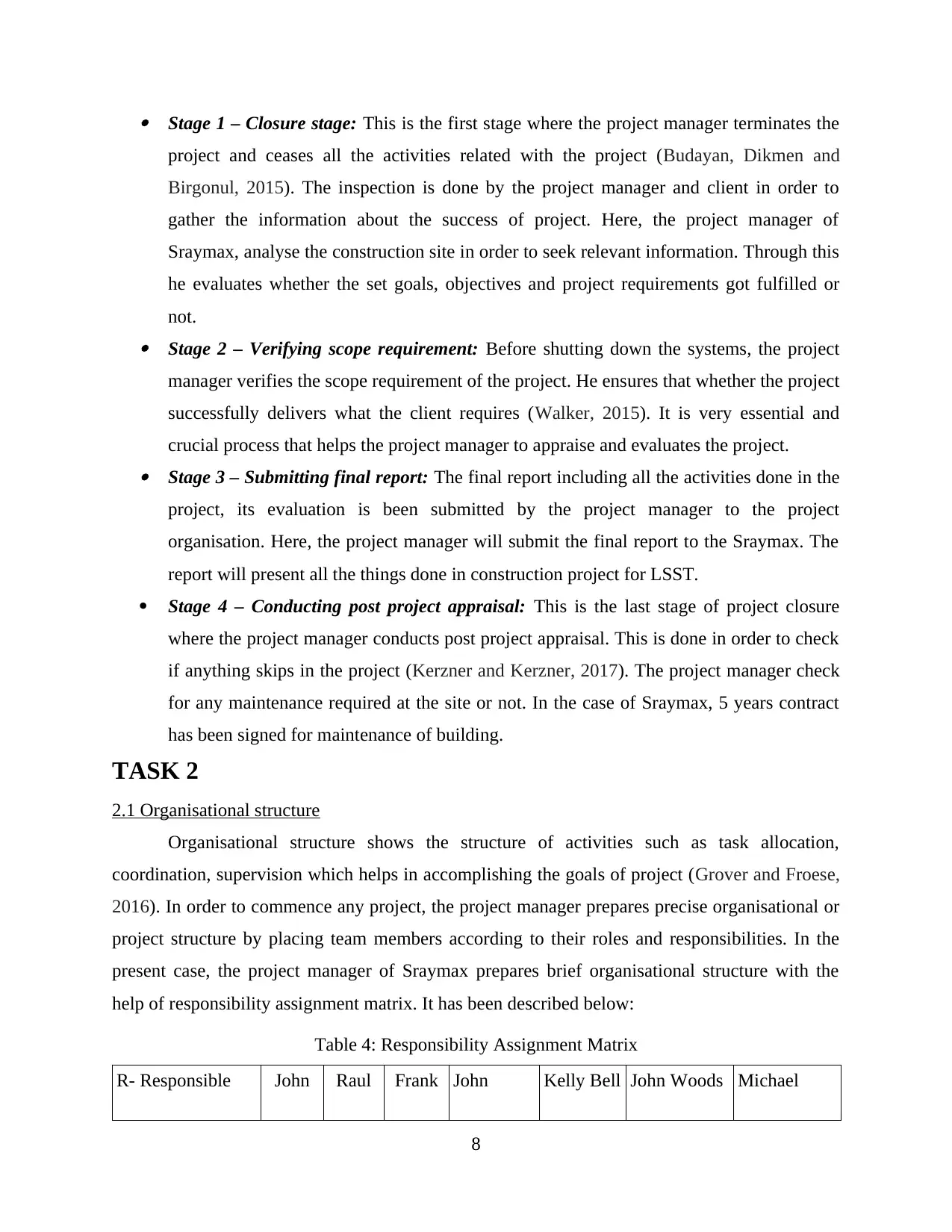
Stage 1 – Closure stage: This is the first stage where the project manager terminates the
project and ceases all the activities related with the project (Budayan, Dikmen and
Birgonul, 2015). The inspection is done by the project manager and client in order to
gather the information about the success of project. Here, the project manager of
Sraymax, analyse the construction site in order to seek relevant information. Through this
he evaluates whether the set goals, objectives and project requirements got fulfilled or
not. Stage 2 – Verifying scope requirement: Before shutting down the systems, the project
manager verifies the scope requirement of the project. He ensures that whether the project
successfully delivers what the client requires (Walker, 2015). It is very essential and
crucial process that helps the project manager to appraise and evaluates the project. Stage 3 – Submitting final report: The final report including all the activities done in the
project, its evaluation is been submitted by the project manager to the project
organisation. Here, the project manager will submit the final report to the Sraymax. The
report will present all the things done in construction project for LSST.
Stage 4 – Conducting post project appraisal: This is the last stage of project closure
where the project manager conducts post project appraisal. This is done in order to check
if anything skips in the project (Kerzner and Kerzner, 2017). The project manager check
for any maintenance required at the site or not. In the case of Sraymax, 5 years contract
has been signed for maintenance of building.
TASK 2
2.1 Organisational structure
Organisational structure shows the structure of activities such as task allocation,
coordination, supervision which helps in accomplishing the goals of project (Grover and Froese,
2016). In order to commence any project, the project manager prepares precise organisational or
project structure by placing team members according to their roles and responsibilities. In the
present case, the project manager of Sraymax prepares brief organisational structure with the
help of responsibility assignment matrix. It has been described below:
Table 4: Responsibility Assignment Matrix
R- Responsible John Raul Frank John Kelly Bell John Woods Michael
8
project and ceases all the activities related with the project (Budayan, Dikmen and
Birgonul, 2015). The inspection is done by the project manager and client in order to
gather the information about the success of project. Here, the project manager of
Sraymax, analyse the construction site in order to seek relevant information. Through this
he evaluates whether the set goals, objectives and project requirements got fulfilled or
not. Stage 2 – Verifying scope requirement: Before shutting down the systems, the project
manager verifies the scope requirement of the project. He ensures that whether the project
successfully delivers what the client requires (Walker, 2015). It is very essential and
crucial process that helps the project manager to appraise and evaluates the project. Stage 3 – Submitting final report: The final report including all the activities done in the
project, its evaluation is been submitted by the project manager to the project
organisation. Here, the project manager will submit the final report to the Sraymax. The
report will present all the things done in construction project for LSST.
Stage 4 – Conducting post project appraisal: This is the last stage of project closure
where the project manager conducts post project appraisal. This is done in order to check
if anything skips in the project (Kerzner and Kerzner, 2017). The project manager check
for any maintenance required at the site or not. In the case of Sraymax, 5 years contract
has been signed for maintenance of building.
TASK 2
2.1 Organisational structure
Organisational structure shows the structure of activities such as task allocation,
coordination, supervision which helps in accomplishing the goals of project (Grover and Froese,
2016). In order to commence any project, the project manager prepares precise organisational or
project structure by placing team members according to their roles and responsibilities. In the
present case, the project manager of Sraymax prepares brief organisational structure with the
help of responsibility assignment matrix. It has been described below:
Table 4: Responsibility Assignment Matrix
R- Responsible John Raul Frank John Kelly Bell John Woods Michael
8
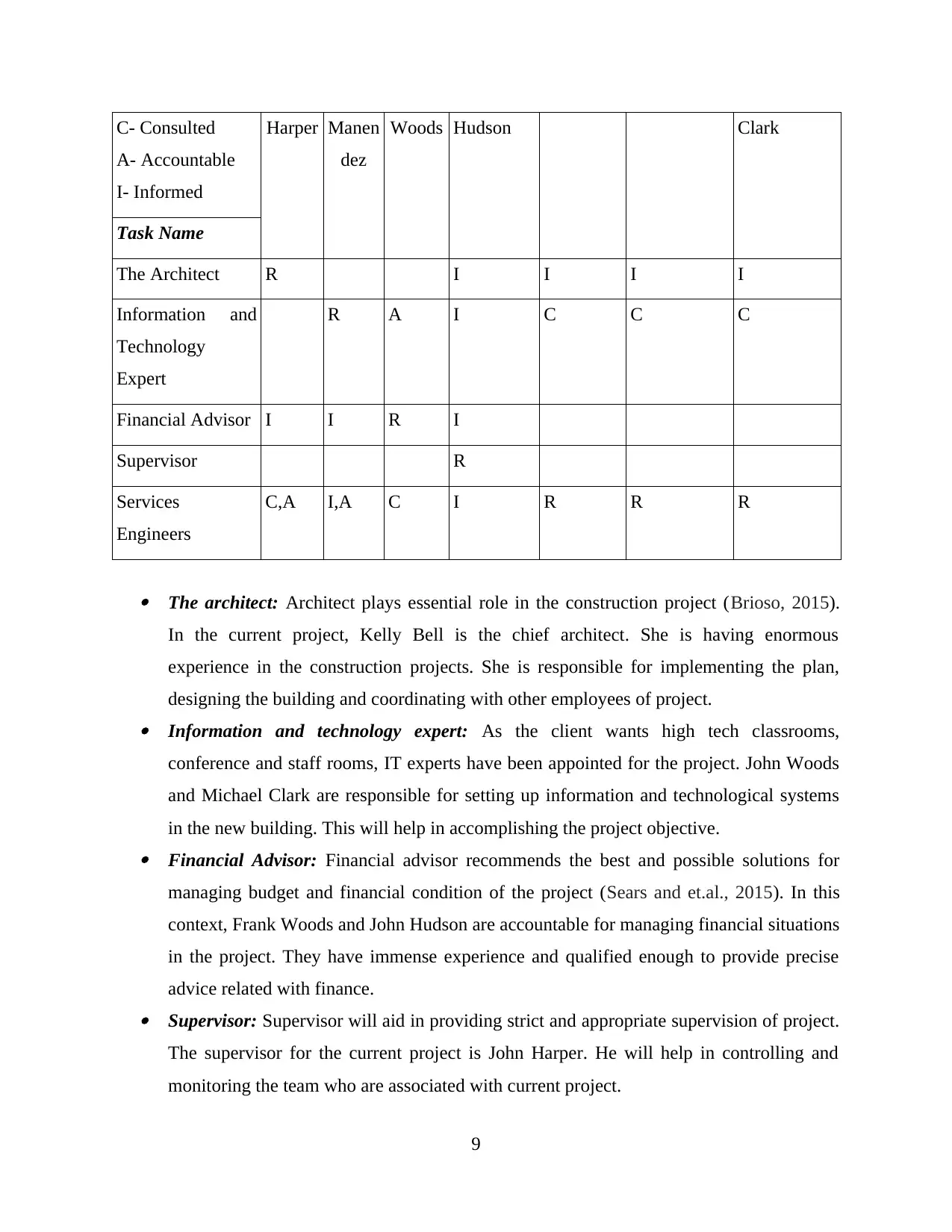
C- Consulted
A- Accountable
I- Informed
Harper Manen
dez
Woods Hudson Clark
Task Name
The Architect R I I I I
Information and
Technology
Expert
R A I C C C
Financial Advisor I I R I
Supervisor R
Services
Engineers
C,A I,A C I R R R
The architect: Architect plays essential role in the construction project (Brioso, 2015).
In the current project, Kelly Bell is the chief architect. She is having enormous
experience in the construction projects. She is responsible for implementing the plan,
designing the building and coordinating with other employees of project. Information and technology expert: As the client wants high tech classrooms,
conference and staff rooms, IT experts have been appointed for the project. John Woods
and Michael Clark are responsible for setting up information and technological systems
in the new building. This will help in accomplishing the project objective. Financial Advisor: Financial advisor recommends the best and possible solutions for
managing budget and financial condition of the project (Sears and et.al., 2015). In this
context, Frank Woods and John Hudson are accountable for managing financial situations
in the project. They have immense experience and qualified enough to provide precise
advice related with finance. Supervisor: Supervisor will aid in providing strict and appropriate supervision of project.
The supervisor for the current project is John Harper. He will help in controlling and
monitoring the team who are associated with current project.
9
A- Accountable
I- Informed
Harper Manen
dez
Woods Hudson Clark
Task Name
The Architect R I I I I
Information and
Technology
Expert
R A I C C C
Financial Advisor I I R I
Supervisor R
Services
Engineers
C,A I,A C I R R R
The architect: Architect plays essential role in the construction project (Brioso, 2015).
In the current project, Kelly Bell is the chief architect. She is having enormous
experience in the construction projects. She is responsible for implementing the plan,
designing the building and coordinating with other employees of project. Information and technology expert: As the client wants high tech classrooms,
conference and staff rooms, IT experts have been appointed for the project. John Woods
and Michael Clark are responsible for setting up information and technological systems
in the new building. This will help in accomplishing the project objective. Financial Advisor: Financial advisor recommends the best and possible solutions for
managing budget and financial condition of the project (Sears and et.al., 2015). In this
context, Frank Woods and John Hudson are accountable for managing financial situations
in the project. They have immense experience and qualified enough to provide precise
advice related with finance. Supervisor: Supervisor will aid in providing strict and appropriate supervision of project.
The supervisor for the current project is John Harper. He will help in controlling and
monitoring the team who are associated with current project.
9
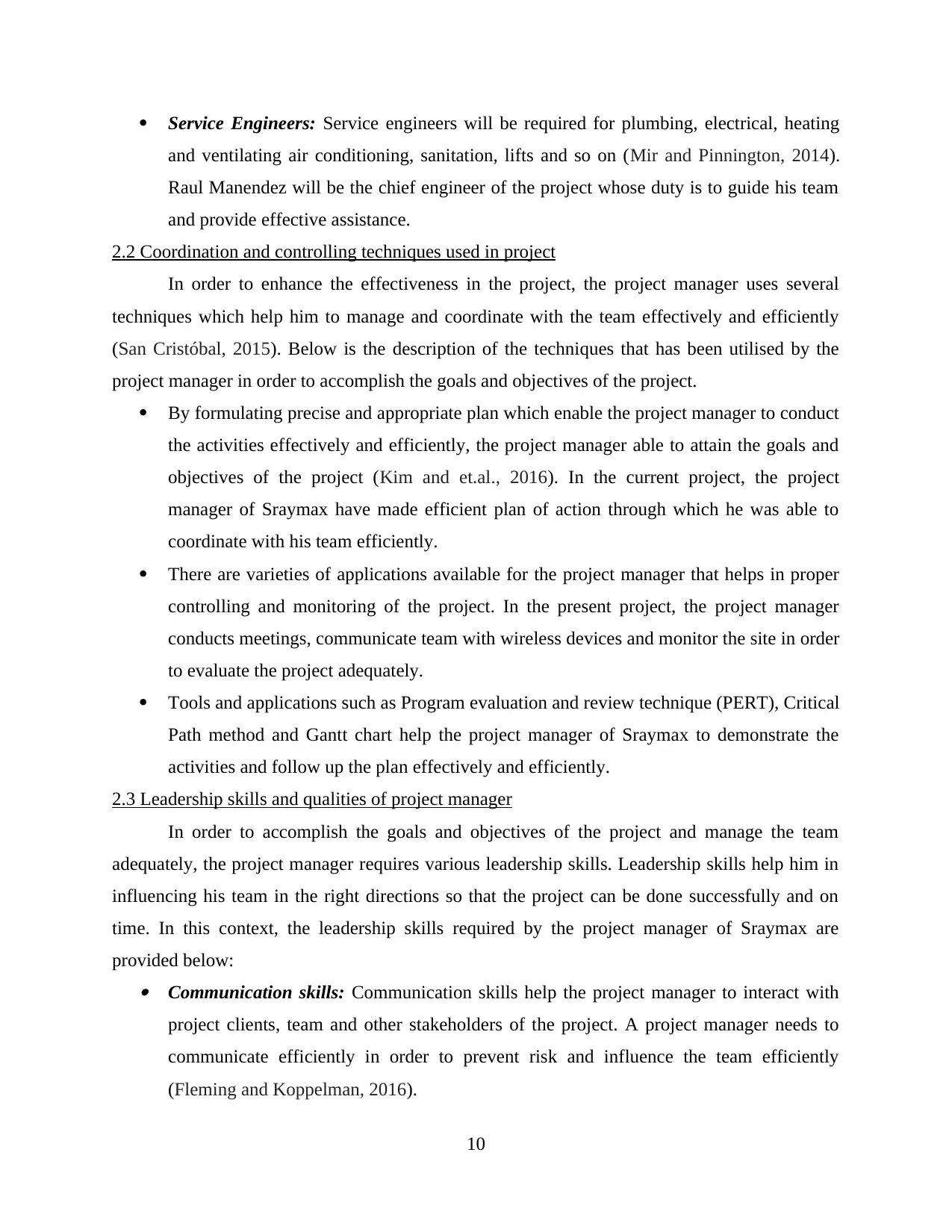
Service Engineers: Service engineers will be required for plumbing, electrical, heating
and ventilating air conditioning, sanitation, lifts and so on (Mir and Pinnington, 2014).
Raul Manendez will be the chief engineer of the project whose duty is to guide his team
and provide effective assistance.
2.2 Coordination and controlling techniques used in project
In order to enhance the effectiveness in the project, the project manager uses several
techniques which help him to manage and coordinate with the team effectively and efficiently
(San Cristóbal, 2015). Below is the description of the techniques that has been utilised by the
project manager in order to accomplish the goals and objectives of the project.
By formulating precise and appropriate plan which enable the project manager to conduct
the activities effectively and efficiently, the project manager able to attain the goals and
objectives of the project (Kim and et.al., 2016). In the current project, the project
manager of Sraymax have made efficient plan of action through which he was able to
coordinate with his team efficiently.
There are varieties of applications available for the project manager that helps in proper
controlling and monitoring of the project. In the present project, the project manager
conducts meetings, communicate team with wireless devices and monitor the site in order
to evaluate the project adequately.
Tools and applications such as Program evaluation and review technique (PERT), Critical
Path method and Gantt chart help the project manager of Sraymax to demonstrate the
activities and follow up the plan effectively and efficiently.
2.3 Leadership skills and qualities of project manager
In order to accomplish the goals and objectives of the project and manage the team
adequately, the project manager requires various leadership skills. Leadership skills help him in
influencing his team in the right directions so that the project can be done successfully and on
time. In this context, the leadership skills required by the project manager of Sraymax are
provided below: Communication skills: Communication skills help the project manager to interact with
project clients, team and other stakeholders of the project. A project manager needs to
communicate efficiently in order to prevent risk and influence the team efficiently
(Fleming and Koppelman, 2016).
10
and ventilating air conditioning, sanitation, lifts and so on (Mir and Pinnington, 2014).
Raul Manendez will be the chief engineer of the project whose duty is to guide his team
and provide effective assistance.
2.2 Coordination and controlling techniques used in project
In order to enhance the effectiveness in the project, the project manager uses several
techniques which help him to manage and coordinate with the team effectively and efficiently
(San Cristóbal, 2015). Below is the description of the techniques that has been utilised by the
project manager in order to accomplish the goals and objectives of the project.
By formulating precise and appropriate plan which enable the project manager to conduct
the activities effectively and efficiently, the project manager able to attain the goals and
objectives of the project (Kim and et.al., 2016). In the current project, the project
manager of Sraymax have made efficient plan of action through which he was able to
coordinate with his team efficiently.
There are varieties of applications available for the project manager that helps in proper
controlling and monitoring of the project. In the present project, the project manager
conducts meetings, communicate team with wireless devices and monitor the site in order
to evaluate the project adequately.
Tools and applications such as Program evaluation and review technique (PERT), Critical
Path method and Gantt chart help the project manager of Sraymax to demonstrate the
activities and follow up the plan effectively and efficiently.
2.3 Leadership skills and qualities of project manager
In order to accomplish the goals and objectives of the project and manage the team
adequately, the project manager requires various leadership skills. Leadership skills help him in
influencing his team in the right directions so that the project can be done successfully and on
time. In this context, the leadership skills required by the project manager of Sraymax are
provided below: Communication skills: Communication skills help the project manager to interact with
project clients, team and other stakeholders of the project. A project manager needs to
communicate efficiently in order to prevent risk and influence the team efficiently
(Fleming and Koppelman, 2016).
10
Paraphrase This Document
Need a fresh take? Get an instant paraphrase of this document with our AI Paraphraser
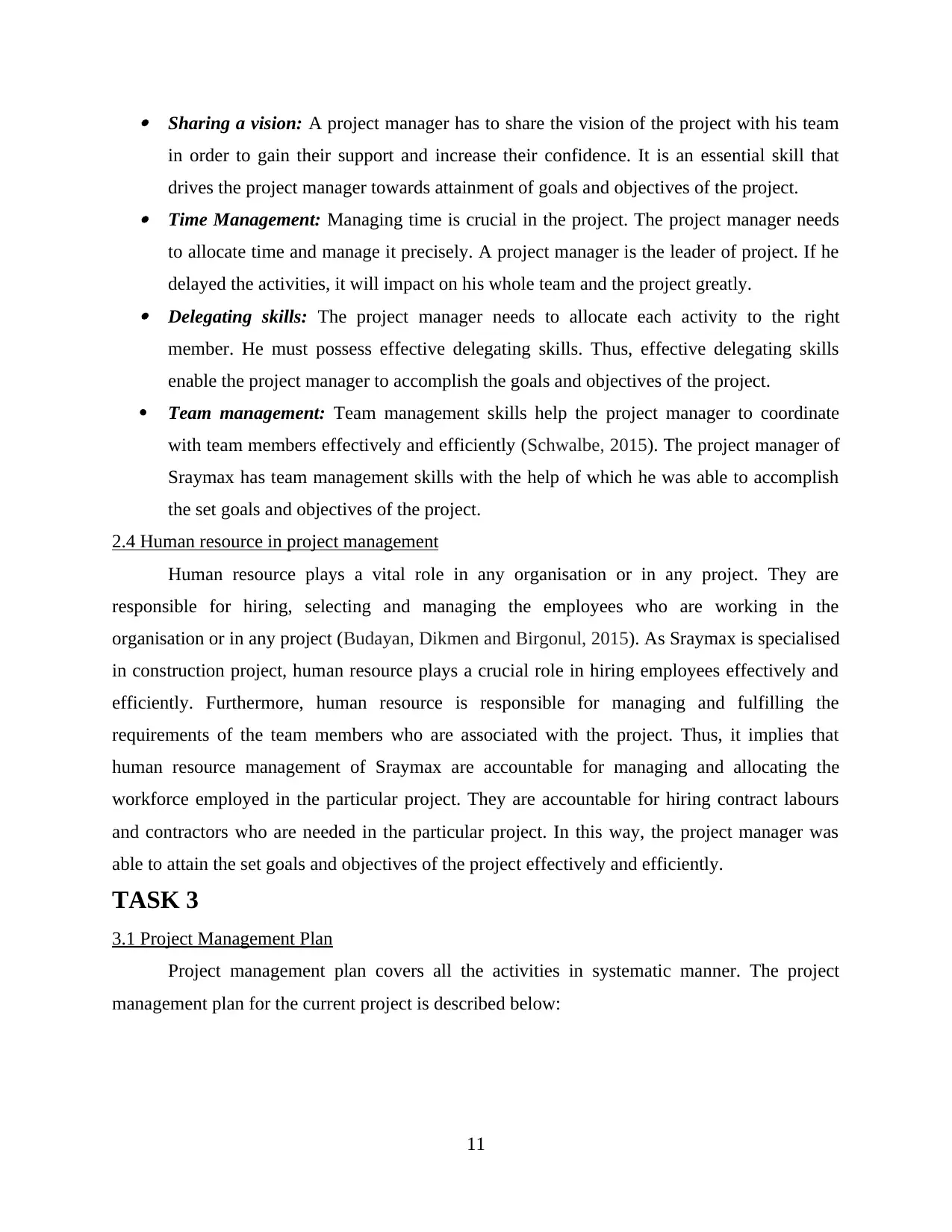
Sharing a vision: A project manager has to share the vision of the project with his team
in order to gain their support and increase their confidence. It is an essential skill that
drives the project manager towards attainment of goals and objectives of the project. Time Management: Managing time is crucial in the project. The project manager needs
to allocate time and manage it precisely. A project manager is the leader of project. If he
delayed the activities, it will impact on his whole team and the project greatly. Delegating skills: The project manager needs to allocate each activity to the right
member. He must possess effective delegating skills. Thus, effective delegating skills
enable the project manager to accomplish the goals and objectives of the project.
Team management: Team management skills help the project manager to coordinate
with team members effectively and efficiently (Schwalbe, 2015). The project manager of
Sraymax has team management skills with the help of which he was able to accomplish
the set goals and objectives of the project.
2.4 Human resource in project management
Human resource plays a vital role in any organisation or in any project. They are
responsible for hiring, selecting and managing the employees who are working in the
organisation or in any project (Budayan, Dikmen and Birgonul, 2015). As Sraymax is specialised
in construction project, human resource plays a crucial role in hiring employees effectively and
efficiently. Furthermore, human resource is responsible for managing and fulfilling the
requirements of the team members who are associated with the project. Thus, it implies that
human resource management of Sraymax are accountable for managing and allocating the
workforce employed in the particular project. They are accountable for hiring contract labours
and contractors who are needed in the particular project. In this way, the project manager was
able to attain the set goals and objectives of the project effectively and efficiently.
TASK 3
3.1 Project Management Plan
Project management plan covers all the activities in systematic manner. The project
management plan for the current project is described below:
11
in order to gain their support and increase their confidence. It is an essential skill that
drives the project manager towards attainment of goals and objectives of the project. Time Management: Managing time is crucial in the project. The project manager needs
to allocate time and manage it precisely. A project manager is the leader of project. If he
delayed the activities, it will impact on his whole team and the project greatly. Delegating skills: The project manager needs to allocate each activity to the right
member. He must possess effective delegating skills. Thus, effective delegating skills
enable the project manager to accomplish the goals and objectives of the project.
Team management: Team management skills help the project manager to coordinate
with team members effectively and efficiently (Schwalbe, 2015). The project manager of
Sraymax has team management skills with the help of which he was able to accomplish
the set goals and objectives of the project.
2.4 Human resource in project management
Human resource plays a vital role in any organisation or in any project. They are
responsible for hiring, selecting and managing the employees who are working in the
organisation or in any project (Budayan, Dikmen and Birgonul, 2015). As Sraymax is specialised
in construction project, human resource plays a crucial role in hiring employees effectively and
efficiently. Furthermore, human resource is responsible for managing and fulfilling the
requirements of the team members who are associated with the project. Thus, it implies that
human resource management of Sraymax are accountable for managing and allocating the
workforce employed in the particular project. They are accountable for hiring contract labours
and contractors who are needed in the particular project. In this way, the project manager was
able to attain the set goals and objectives of the project effectively and efficiently.
TASK 3
3.1 Project Management Plan
Project management plan covers all the activities in systematic manner. The project
management plan for the current project is described below:
11
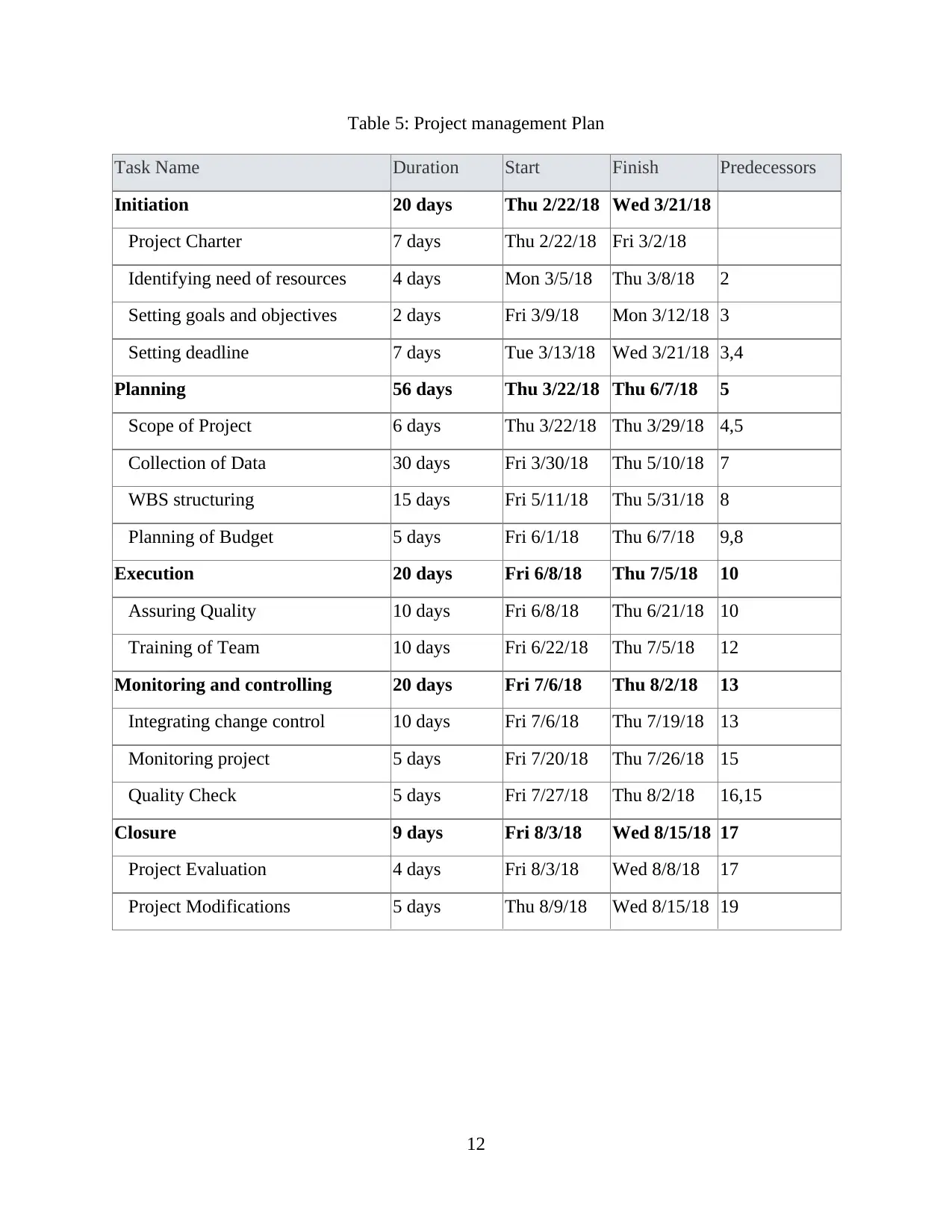
Table 5: Project management Plan
Task Name Duration Start Finish Predecessors
Initiation 20 days Thu 2/22/18 Wed 3/21/18
Project Charter 7 days Thu 2/22/18 Fri 3/2/18
Identifying need of resources 4 days Mon 3/5/18 Thu 3/8/18 2
Setting goals and objectives 2 days Fri 3/9/18 Mon 3/12/18 3
Setting deadline 7 days Tue 3/13/18 Wed 3/21/18 3,4
Planning 56 days Thu 3/22/18 Thu 6/7/18 5
Scope of Project 6 days Thu 3/22/18 Thu 3/29/18 4,5
Collection of Data 30 days Fri 3/30/18 Thu 5/10/18 7
WBS structuring 15 days Fri 5/11/18 Thu 5/31/18 8
Planning of Budget 5 days Fri 6/1/18 Thu 6/7/18 9,8
Execution 20 days Fri 6/8/18 Thu 7/5/18 10
Assuring Quality 10 days Fri 6/8/18 Thu 6/21/18 10
Training of Team 10 days Fri 6/22/18 Thu 7/5/18 12
Monitoring and controlling 20 days Fri 7/6/18 Thu 8/2/18 13
Integrating change control 10 days Fri 7/6/18 Thu 7/19/18 13
Monitoring project 5 days Fri 7/20/18 Thu 7/26/18 15
Quality Check 5 days Fri 7/27/18 Thu 8/2/18 16,15
Closure 9 days Fri 8/3/18 Wed 8/15/18 17
Project Evaluation 4 days Fri 8/3/18 Wed 8/8/18 17
Project Modifications 5 days Thu 8/9/18 Wed 8/15/18 19
12
Task Name Duration Start Finish Predecessors
Initiation 20 days Thu 2/22/18 Wed 3/21/18
Project Charter 7 days Thu 2/22/18 Fri 3/2/18
Identifying need of resources 4 days Mon 3/5/18 Thu 3/8/18 2
Setting goals and objectives 2 days Fri 3/9/18 Mon 3/12/18 3
Setting deadline 7 days Tue 3/13/18 Wed 3/21/18 3,4
Planning 56 days Thu 3/22/18 Thu 6/7/18 5
Scope of Project 6 days Thu 3/22/18 Thu 3/29/18 4,5
Collection of Data 30 days Fri 3/30/18 Thu 5/10/18 7
WBS structuring 15 days Fri 5/11/18 Thu 5/31/18 8
Planning of Budget 5 days Fri 6/1/18 Thu 6/7/18 9,8
Execution 20 days Fri 6/8/18 Thu 7/5/18 10
Assuring Quality 10 days Fri 6/8/18 Thu 6/21/18 10
Training of Team 10 days Fri 6/22/18 Thu 7/5/18 12
Monitoring and controlling 20 days Fri 7/6/18 Thu 8/2/18 13
Integrating change control 10 days Fri 7/6/18 Thu 7/19/18 13
Monitoring project 5 days Fri 7/20/18 Thu 7/26/18 15
Quality Check 5 days Fri 7/27/18 Thu 8/2/18 16,15
Closure 9 days Fri 8/3/18 Wed 8/15/18 17
Project Evaluation 4 days Fri 8/3/18 Wed 8/8/18 17
Project Modifications 5 days Thu 8/9/18 Wed 8/15/18 19
12
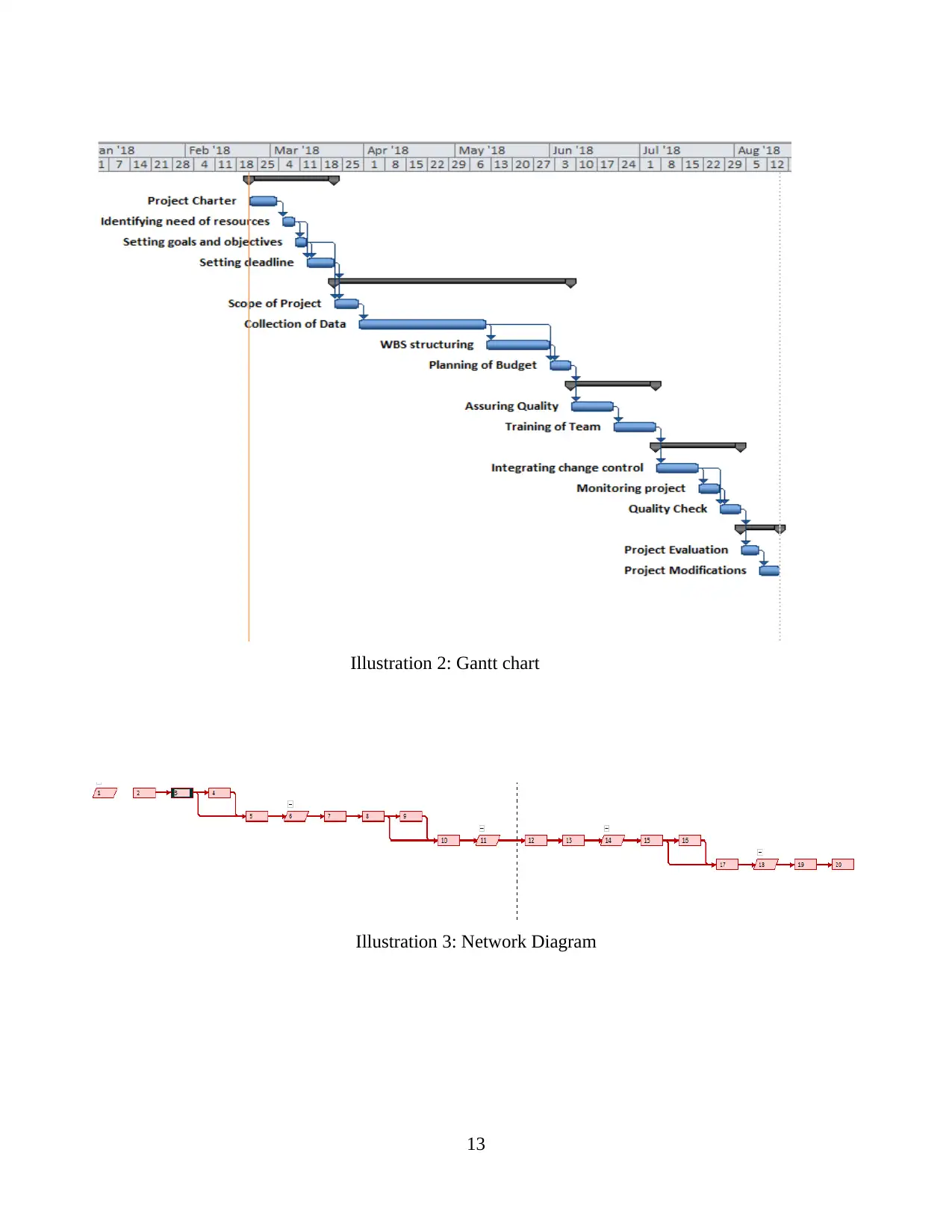
13
Illustration 3: Network Diagram
Illustration 2: Gantt chart
Illustration 3: Network Diagram
Illustration 2: Gantt chart
Secure Best Marks with AI Grader
Need help grading? Try our AI Grader for instant feedback on your assignments.
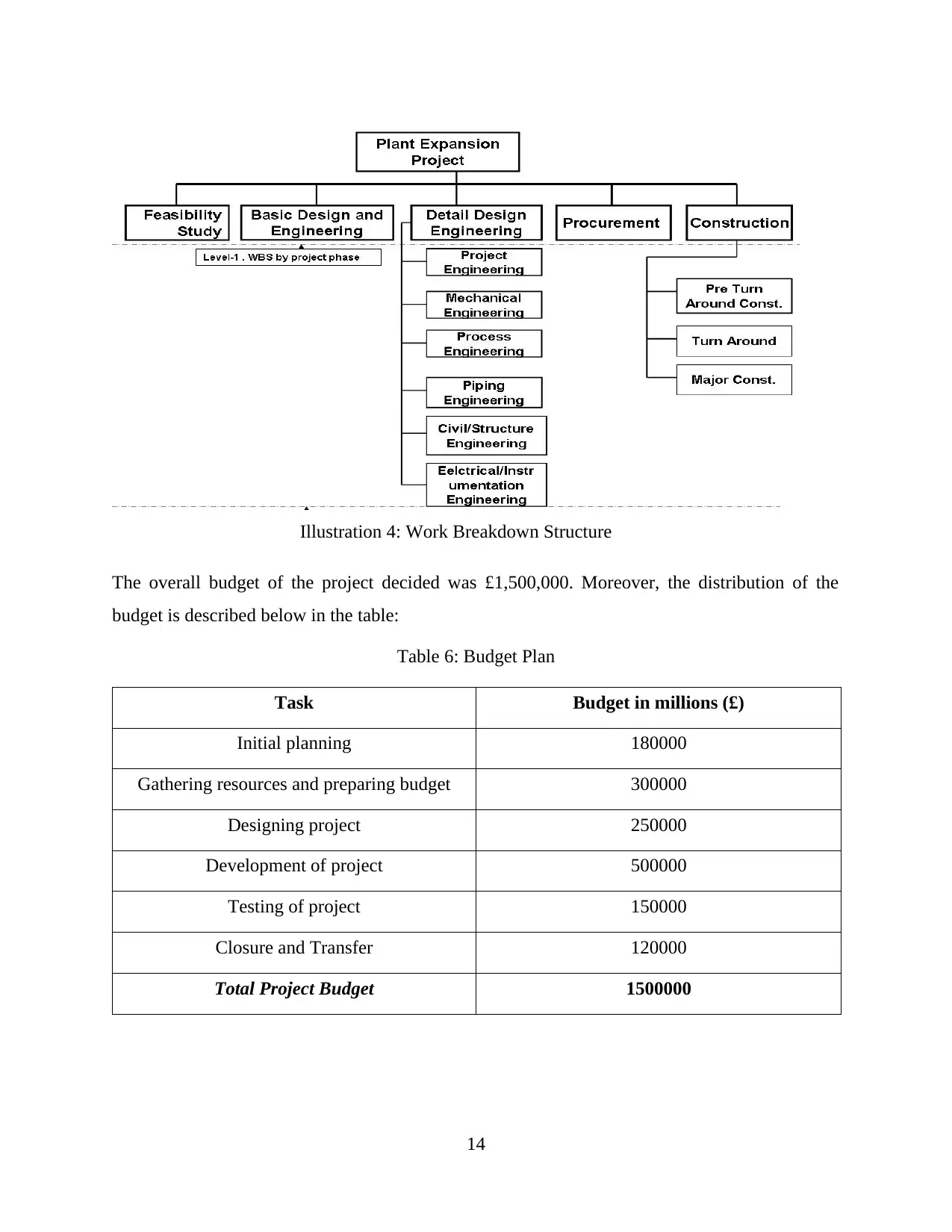
Illustration 4: Work Breakdown Structure
The overall budget of the project decided was £1,500,000. Moreover, the distribution of the
budget is described below in the table:
Table 6: Budget Plan
Task Budget in millions (£)
Initial planning 180000
Gathering resources and preparing budget 300000
Designing project 250000
Development of project 500000
Testing of project 150000
Closure and Transfer 120000
Total Project Budget 1500000
14
The overall budget of the project decided was £1,500,000. Moreover, the distribution of the
budget is described below in the table:
Table 6: Budget Plan
Task Budget in millions (£)
Initial planning 180000
Gathering resources and preparing budget 300000
Designing project 250000
Development of project 500000
Testing of project 150000
Closure and Transfer 120000
Total Project Budget 1500000
14
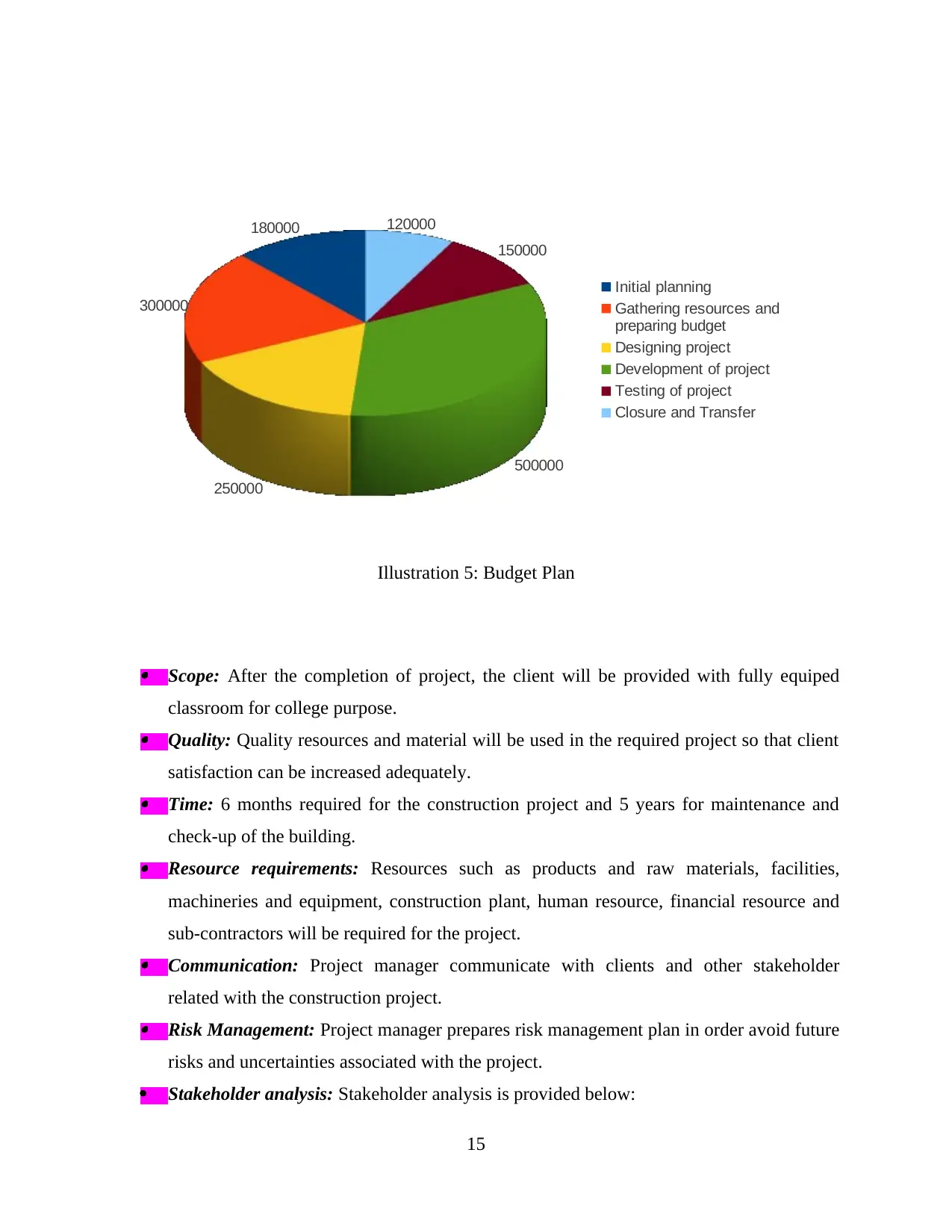
Scope: After the completion of project, the client will be provided with fully equiped
classroom for college purpose. Quality: Quality resources and material will be used in the required project so that client
satisfaction can be increased adequately. Time: 6 months required for the construction project and 5 years for maintenance and
check-up of the building. Resource requirements: Resources such as products and raw materials, facilities,
machineries and equipment, construction plant, human resource, financial resource and
sub-contractors will be required for the project. Communication: Project manager communicate with clients and other stakeholder
related with the construction project. Risk Management: Project manager prepares risk management plan in order avoid future
risks and uncertainties associated with the project.
Stakeholder analysis: Stakeholder analysis is provided below:
15
180000
300000
250000
500000
150000
120000
Initial planning
Gathering resources and
preparing budget
Designing project
Development of project
Testing of project
Closure and Transfer
Illustration 5: Budget Plan
classroom for college purpose. Quality: Quality resources and material will be used in the required project so that client
satisfaction can be increased adequately. Time: 6 months required for the construction project and 5 years for maintenance and
check-up of the building. Resource requirements: Resources such as products and raw materials, facilities,
machineries and equipment, construction plant, human resource, financial resource and
sub-contractors will be required for the project. Communication: Project manager communicate with clients and other stakeholder
related with the construction project. Risk Management: Project manager prepares risk management plan in order avoid future
risks and uncertainties associated with the project.
Stakeholder analysis: Stakeholder analysis is provided below:
15
180000
300000
250000
500000
150000
120000
Initial planning
Gathering resources and
preparing budget
Designing project
Development of project
Testing of project
Closure and Transfer
Illustration 5: Budget Plan
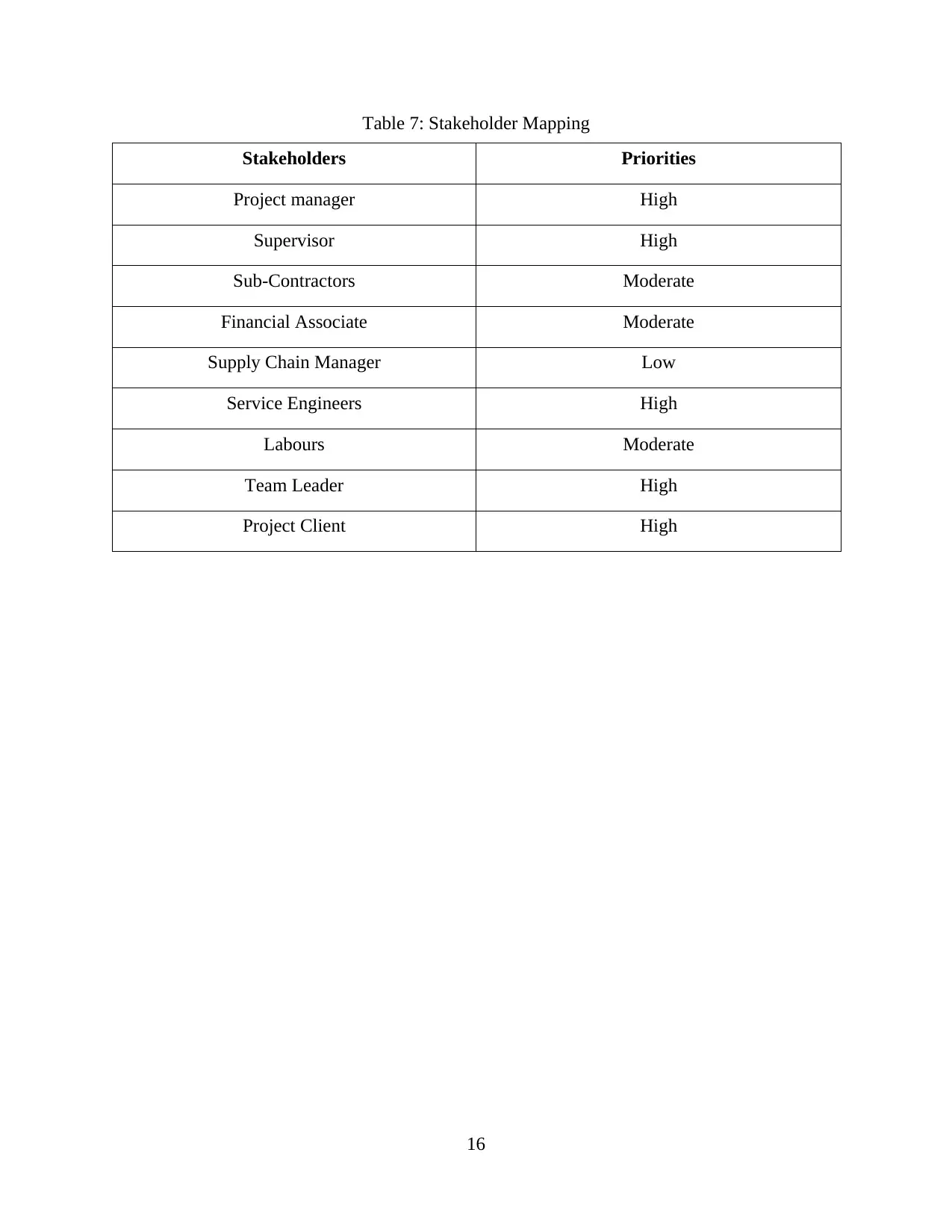
Table 7: Stakeholder Mapping
Stakeholders Priorities
Project manager High
Supervisor High
Sub-Contractors Moderate
Financial Associate Moderate
Supply Chain Manager Low
Service Engineers High
Labours Moderate
Team Leader High
Project Client High
16
Stakeholders Priorities
Project manager High
Supervisor High
Sub-Contractors Moderate
Financial Associate Moderate
Supply Chain Manager Low
Service Engineers High
Labours Moderate
Team Leader High
Project Client High
16
Paraphrase This Document
Need a fresh take? Get an instant paraphrase of this document with our AI Paraphraser

3.2 Project controlling techniques
In order to minimise the time and costs of the project, the project manager has
implemented scheduling, estimation and cost control techniques. These are basic strategies that
are followed by the project manager in order to reduce the efforts and risk associated with the
project. Scheduling: In a project constraint polygon, scheduling is considered as one of the most
crucial technique (Walker, 2015). Without precise scheduling of activities, the project
manager could not be able to attain the goals and objectives of the project. Estimation: Estimating is the process through which the project manager anticipate
various attributes that influence the project (Kerzner and Kerzner, 2017). The project
manager estimates the cost of resources and materials in order to save costs.
Cost Control: Cost control is the technique used by the project manager where he reduces
the cost incurred in the project without compromising the quality of project.
17
Illustration 6: Stakeholder Analysis
In order to minimise the time and costs of the project, the project manager has
implemented scheduling, estimation and cost control techniques. These are basic strategies that
are followed by the project manager in order to reduce the efforts and risk associated with the
project. Scheduling: In a project constraint polygon, scheduling is considered as one of the most
crucial technique (Walker, 2015). Without precise scheduling of activities, the project
manager could not be able to attain the goals and objectives of the project. Estimation: Estimating is the process through which the project manager anticipate
various attributes that influence the project (Kerzner and Kerzner, 2017). The project
manager estimates the cost of resources and materials in order to save costs.
Cost Control: Cost control is the technique used by the project manager where he reduces
the cost incurred in the project without compromising the quality of project.
17
Illustration 6: Stakeholder Analysis
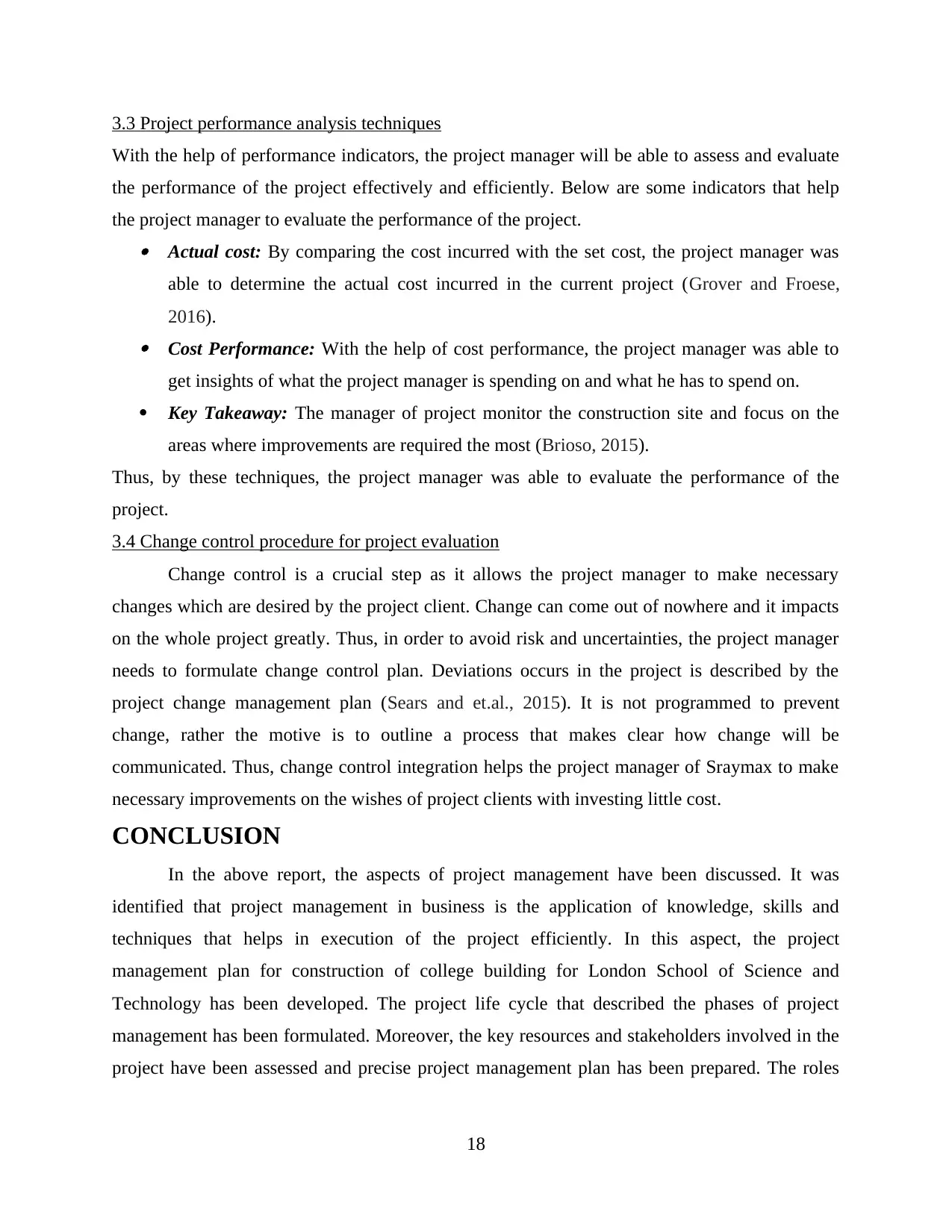
3.3 Project performance analysis techniques
With the help of performance indicators, the project manager will be able to assess and evaluate
the performance of the project effectively and efficiently. Below are some indicators that help
the project manager to evaluate the performance of the project. Actual cost: By comparing the cost incurred with the set cost, the project manager was
able to determine the actual cost incurred in the current project (Grover and Froese,
2016). Cost Performance: With the help of cost performance, the project manager was able to
get insights of what the project manager is spending on and what he has to spend on.
Key Takeaway: The manager of project monitor the construction site and focus on the
areas where improvements are required the most (Brioso, 2015).
Thus, by these techniques, the project manager was able to evaluate the performance of the
project.
3.4 Change control procedure for project evaluation
Change control is a crucial step as it allows the project manager to make necessary
changes which are desired by the project client. Change can come out of nowhere and it impacts
on the whole project greatly. Thus, in order to avoid risk and uncertainties, the project manager
needs to formulate change control plan. Deviations occurs in the project is described by the
project change management plan (Sears and et.al., 2015). It is not programmed to prevent
change, rather the motive is to outline a process that makes clear how change will be
communicated. Thus, change control integration helps the project manager of Sraymax to make
necessary improvements on the wishes of project clients with investing little cost.
CONCLUSION
In the above report, the aspects of project management have been discussed. It was
identified that project management in business is the application of knowledge, skills and
techniques that helps in execution of the project efficiently. In this aspect, the project
management plan for construction of college building for London School of Science and
Technology has been developed. The project life cycle that described the phases of project
management has been formulated. Moreover, the key resources and stakeholders involved in the
project have been assessed and precise project management plan has been prepared. The roles
18
With the help of performance indicators, the project manager will be able to assess and evaluate
the performance of the project effectively and efficiently. Below are some indicators that help
the project manager to evaluate the performance of the project. Actual cost: By comparing the cost incurred with the set cost, the project manager was
able to determine the actual cost incurred in the current project (Grover and Froese,
2016). Cost Performance: With the help of cost performance, the project manager was able to
get insights of what the project manager is spending on and what he has to spend on.
Key Takeaway: The manager of project monitor the construction site and focus on the
areas where improvements are required the most (Brioso, 2015).
Thus, by these techniques, the project manager was able to evaluate the performance of the
project.
3.4 Change control procedure for project evaluation
Change control is a crucial step as it allows the project manager to make necessary
changes which are desired by the project client. Change can come out of nowhere and it impacts
on the whole project greatly. Thus, in order to avoid risk and uncertainties, the project manager
needs to formulate change control plan. Deviations occurs in the project is described by the
project change management plan (Sears and et.al., 2015). It is not programmed to prevent
change, rather the motive is to outline a process that makes clear how change will be
communicated. Thus, change control integration helps the project manager of Sraymax to make
necessary improvements on the wishes of project clients with investing little cost.
CONCLUSION
In the above report, the aspects of project management have been discussed. It was
identified that project management in business is the application of knowledge, skills and
techniques that helps in execution of the project efficiently. In this aspect, the project
management plan for construction of college building for London School of Science and
Technology has been developed. The project life cycle that described the phases of project
management has been formulated. Moreover, the key resources and stakeholders involved in the
project have been assessed and precise project management plan has been prepared. The roles
18
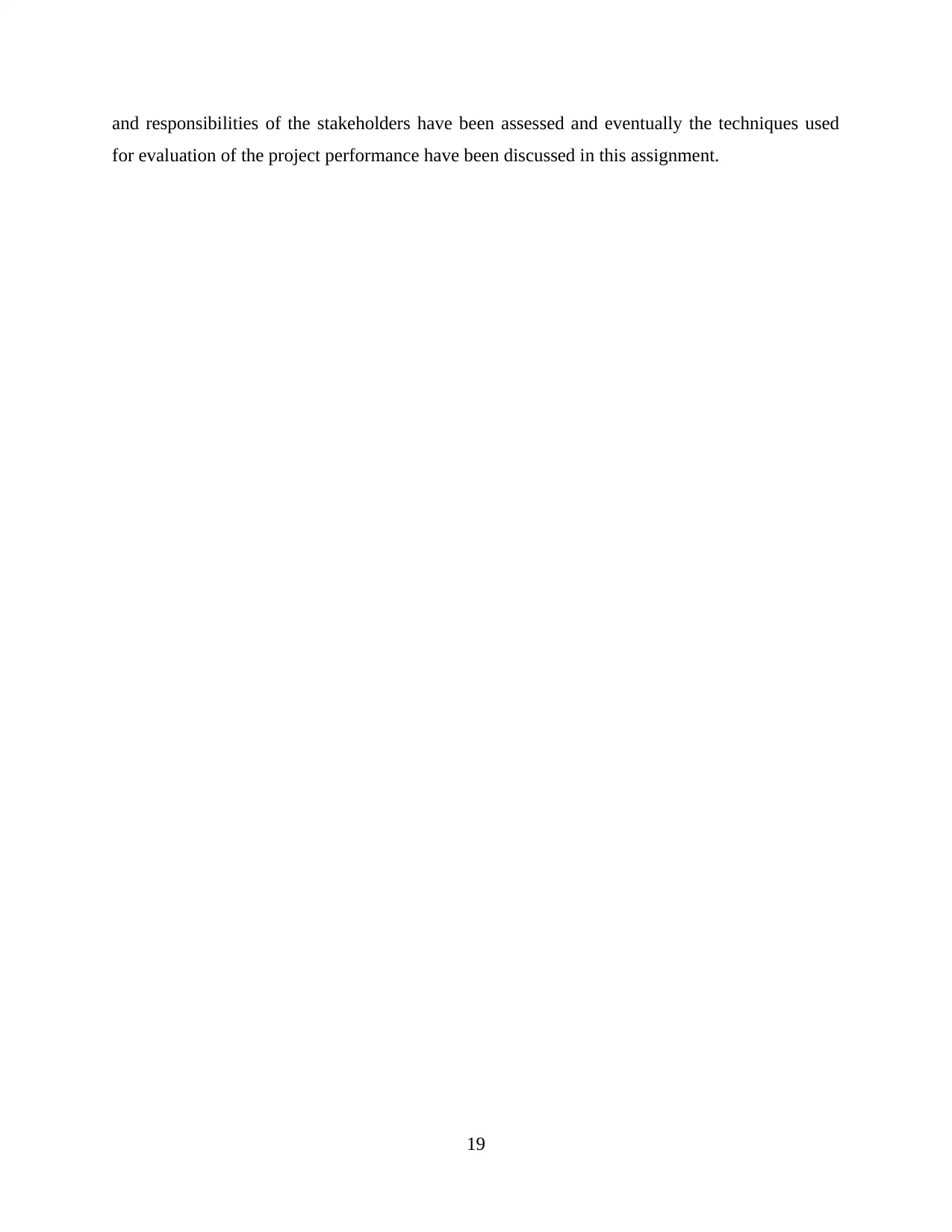
and responsibilities of the stakeholders have been assessed and eventually the techniques used
for evaluation of the project performance have been discussed in this assignment.
19
for evaluation of the project performance have been discussed in this assignment.
19
1 out of 22
Related Documents
Your All-in-One AI-Powered Toolkit for Academic Success.
+13062052269
info@desklib.com
Available 24*7 on WhatsApp / Email
![[object Object]](/_next/static/media/star-bottom.7253800d.svg)
Unlock your academic potential
© 2024 | Zucol Services PVT LTD | All rights reserved.





